Memories versus War Stories
Unlike the War Stories section, Memories are objective essays containing facts and information pertaining to the DEWLine itself, its history, places, equipment, living conditions, and personal experiences that speak to life on the Line.
Be sure to visit the War Stories section for a more subjective view of life on the Line and read some of the anecdotes that DEWLiners would share with one another, if they could, over a beer (or two) on a Saturday night at the bar.
CONTENTS
- Memories of Fox Main
- Return to the DEWLine – 50 Years Later
- The DEWLine Family
- Ice-Cap Memories
- Nineteen Months in Retrospect – Part One
- Nineteen Months in Retrospect – Part Two
- The Evolution of the DEWLine Training Centers – Streator and Beyond
- The Early Years. Before the Line went live. As it was in the beginning.
MEMORIES OF FOX MAIN
By Paul Kelley
With additional comments and clarification by Clive Beckmann appended.
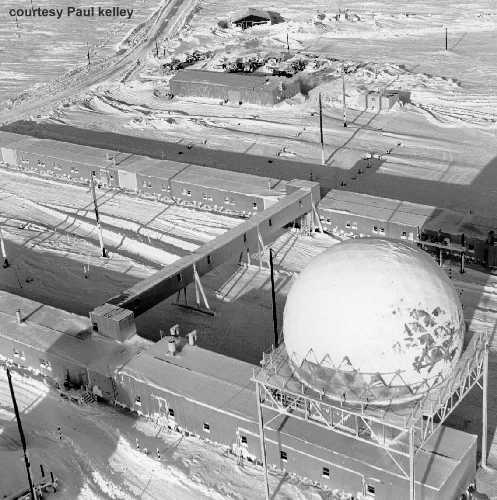
The “electronic modules” are shown at the bottom right of the photo.
To the right of the bridge, in the foreground of the photo, were the electronic modules. This was the kingdom of the radicians and the raison d’etre for the whole show. There were 7 modules in total, all of which were larger than the standard modules. Just inside the 8 windows you see on the photo was a hallway that ran from one end to the other. Walking down this hall from left to right there would be 7 doors at intervals on your left, one for each equipment room. To gain access to this hall you had to punch in a security code on a key pad to open the hall door. The only personnel who usually came in to this area were the radicians and the military controllers.
Starting from left and proceeding to the right the rooms were:
- 1.The IS-101 Ionospheric Scatter System – Jean Paul’s little world and about which I knew next to nothing.
- 2.The Communications Centre – Glynn Nolan’s world but with a locked cubby hole in the corner where I played with my ‘Enigma’.
- 3.The transmitter room housing all the air-to-ground transmitters as well as the FRC-45 lateral transmitter.
- 4.The receiver room housing all of the receivers for the systems in 3 above as well as the FPS-23 Doppler radar receiver linked to CAM-F at Sarcpa Lake 50 miles to the W. See below for the E Doppler link.
- 5.The surveillance room. This was divided in two parts. The half on this side nearest the door was the console room and the far half, separated by a heavy sliding curtain, was the data centre staffed by one of the RCAF/USAF officers.
- 6.The FPS-19 radar room directly under the plenum chamber leading up to the radome and antenna. This housed the two transmitters and receivers, one pair for each of the upper and lower beam.
- 7.The TTY repair room and workshop. Unlike any of the other main sites, this room also housed a Doppler radar transmitter which covered the link to FOX 1 50 miles to the E on Rowley Island. It provided the added bonus of keeping the room nice and warm. Nothing like a klystron cooking in the corner! See below.
HALL BEACH AND ROWLEY ISLAND – FOX MAIN AND FOX 1
Rowley Island was located about 50 miles slightly N of E of Hall Beach. It was the location of the Aux Site, FOX 1. This was the only location (I think) on the DEWline where two Aux, or an Aux and a Main site, did not have an I-site in between – there was only water in between. So the geography of the location demanded a slightly different configuration of equipment than usual. As I mentioned earlier, the I-sites usually housed the Doppler transmitters and the adjacent M or A-sites would house the corresponding receivers for each link. The solution arrived at in this instance was to keep the configuration at the A-site standard, ie, two receivers, and Fox Main would substitute for the missing I-site and house the transmitter. Hence the reason for this kit in the TTY repair room.
One final note regarding the photo of the electronic modules (above). If you look at the photo, just to the left of the radome and on the far side of the electronic modules, you will see a a vertical pole about 30′ high. This was the LF Beacon antenna transmitting UX on 239 khz. This pole was also 68-45-25N 81-13-35W, the geographic coordinates designated as Hall Beach in 1961.
You might think the description of this photo has been a bit windy but it will save a lot of time later as I can now just make reference to all these things without having to explain.
THE SCENE – The Surveillance Room
Now for some more detailed familiarization.
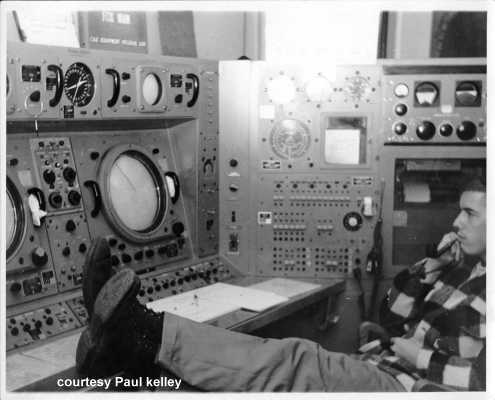
A (leisurely) Paul Kelley on console duty.
This is the Surveillance Room and, directly behind the console, separated by a light proof curtain, is the Data Centre occupied by the duty military controller for the FOX Sector. The first thing that you have to imagine is that this is in total darkness bar the scope and the indicator lights all over the console. Unfortunately my skills were not up to taking a lengthy time exposure and so I had to rely on the flash which rather destroys the eerie atmosphere.
The pose you see me in was typical of a Sunday night shift during my 4 hour stint on the console -ie, no traffic, commercial or military.
THE CONTROLS AND THEIR FUNCTION
HAMMERLUND SP600 RECEIVER
Above my head is a Hammerlund SP600 multiband receiver. It was there primarily for our pleasure but could be used as a backup receiver if necessary. During the quiet moments we would listen to the BBC, Voice of America, Radio Moscow etc and compare and contrast coverage of the same events. An interesting study in what would now be called ‘spin’ if ever there was. The BBC seemed always to tread the middle ground and was, ipso facto, our station of choice. In the winter months we could also pick up commercial radio stations from down south -Chicago, Winnipeg etc.
One night when Winnipeg was coming in well I went into the Communications Centre and sent a TTY (teletype) message down to our gal in the hangar in Winnipeg and put in a request for a song. I can’t recall what it was but she rang the radio station with the request and, a few minutes later, the DJ is saying that he has this request from some guys up in the NWT north of the Arctic Circle and can’t believe it – not only that we are listening to them but that there was anybody up there at all! He played the song. Good fun.
One other station we picked up during the winter months really puzzled us the first time we heard it on the broadcast band (MW). It was playing all the latest rock and roll, the DJ was definitely American and the station was booming in – yet we hadn’t heard it before. When the station identification was made this answered the question. ‘This is KOLD, Thule, Your Tower of Power in the Far North’. We only picked them up in the dark period of winter Dec – Jan. If you haven’t gathered already, the general rule was that the lower the transmission frequencies came in much better in the when not interfered with by sunlight.
Once I grew accustomed to the selectivity, sensitivity and controllability (if there is such a word) of receivers like the Hammerlund and the Collins 51N2B in the ham room, it really was frustrating, when back down south, to have a radio with just one tuning knob. Once you get used to tuning 2 RF, 1 IF and an Audio stage not to mention squelch control and sundry other little items, trying to tune in a weak station with only one control is infuriating.
TRACKING LOG TTY
Under the Hammerlund is an RO (Receive Only) TTY with a narrow roll of paper in it. This was activated whenever I submitted a ‘track’ to the data centre and used as a log for all console traffic to the data centre. It was in a semi sound proof enclosure so the clatter would not interfere with our air-to-ground traffic. More in a bit.
WEATHER INSTRUMENTS
To the left of the Hammerlund are the weather instruments. The three smaller circular instruments at the top are, from left to right, temperature, wind speed, wind direction all remoted from a thermometer and anemometer on top of the building. The larger circular instrument beneath them is the barometer. Above the lot and blanked out in the flash is a plastic sheet to record any requests for aviation weather by aircraft. It took about 30 sec to work up what was necessary if requested. I can’t for the life of me recall what was behind the little glass door next to the barometer.
COMMUNICATION CONTROLS
Below the weather instruments the sequence of switches 2-11-1 from left to right, each with an indicator light (receive above and transmit below), were the remote controls for all the air-to-ground and ground-to-ground transmitters and receivers – HF, VHF, UHF, Mobile etc. When an aircraft called on 122.2 mhz, the civil VHF frequency, I would hear them on the speaker (I think it was on the other side of the console) and the indicator above the corresponding toggle switch would light. I would then pick up the hand set (when we were busy we could use it as a headset), depress the transmitter switch which would mute the speaker, put out the receive indicator above and light the transmit indicator below and respond through the handset. Etc for all of the others in this row. The single switch on the right activated the telephone if I wanted to call within the station, make an announcement over the PA system or call any other station on the DEWline.
ASIDE – COMMUNICATIONS FUN AND GAMES
Using the telephone and the lateral communications system you could ring any station E or W of you and beyond. We all knew this and frequently had occasion to dial 61 for CAM Main 500 miles to the W or 60 to ring DYE Main 500 miles to the E. One night I thought it would be fun to really test the whole system.
I dialed 61-61-61-61. The first 61 gave me CAM Main which gave me a dial tone enabling me to ring any extension on the site. I then dialed 61 again which gave me PIN Main and a dial tone etc. The 4th 61 gave me POW Main in Point Barrow, Alaska. At POW there was a rearward operator for whom we had the extension. I dialed that and asked for Elmendorf AFB near Fairbanks. I then asked the Elmendorf operator for McCord AFB near Seattle. I then asked the McCord operator for NORAD in Cheyenne Mountain near Colorado Springs. I then asked the NORAD operator Northern NORAD in Montreal. I then asked the NN operator for RCAF Goose Bay. I asked the Goose operator for Resolution Island (just S of Baffin Island in Hudson Straits. I then asked Resolution to patch me through to Brevoort Island just E of Baffin in Davis Strait. I then asked the Brevoort operator to patch me through to DYE Main.
When I got the DYE Main dial tone I dialed 61 which gave me the FOX Main dial tone. I then dialed the extension of the military controller in the next room. He knew what I had been doing and was waiting for the call. Hi, this is the console! Superb connection albeit about 10000 miles in length. It proved a point but although I am not sure what it was I had fun doing it.
Back to the console:
I am not sure now about the middle row of toggle switches, 6 + 3, but I think they were just more of the same, but I don’t recall for sure.
At the bottom you will see two pairs of toggle switches surrounded by four lights and four buttons on each side. One switch of each pair was a transmit switch and the other a receive switch. Each of the 4 button/light pairs on each side of the pair of switches corresponded to a dedicated line to the console operator of each site in the sector or the data centre in the next room. It was, essentially, a big party line dedicated to the consoles of the sector. Using it the controller could talk to all of us at once. Individual console operators would use it to advise the adjacent site of a lateral flight about to enter their space.
If I wanted to talk to the console at FOX 1 I would depress the transmit switch and press the button corresponding to FOX 1 and a buzzer would ring and light a light at his console – and vice versa.
I don’t recall what the four controls on the vertical panel to the left of the weather instruments and comm controls were for.
THE TAPE RECORDER
Below the ‘desk’ and under the Comms panel in vacant space was a Telefunken 8″ reel to reel tape recorder. This was before cassettes had appeared on the scene. The idea was that this little beast would recall any conversations over the hand set for future reference. It was a glorious pain in the backside. Nobody was trained to fix the thing and it was continually jamming. Some of the more experienced guys had a go and it would then work for a while until it decided enough was enough and pack up again. When everyone else had given up I even spent several hours in the workshop with it one night to see if I could figure out what was going wrong. I figured I couldn’t do any harm to it and treated it as yet another opportunity to learn something new. I met with no better success than the others. There was no backup unit for this and it was, in essence, disregarded by one and all. If it worked – fine. If not – fine. It was not on the schedule of reportable equipment (preventive and corrective maintenance log) and was just left to do its thing if it felt like it. This was to result in a certain amount of embarrassment at one point in the future, more of which later.
THE LEFT SIDE OF THE CONSOLE
Although not in shot, this was identical to the right with one exception. The space where the Hammerlund receiver is on the right was occupied by the electro sensitive pen apparatus which sprung to life if any aircraft were penetrating any of the E-W Doppler ‘gates’ between CAM-F and FOX Main or FOX Main and FOX 1. As I mentioned earlier, it didn’t have to light up and ring a bell, as it did, because the smell was enough to get anybody’s attention.
THE CENTRE OF THE CONSOLE
The layout in the centre was designed for two operators to work simultaneously, the one on the left on the upper beam and the one on the right the lower beam. We seldom did this as the lower beam was sufficient to cover most everything. Therefore, except when training a new guy, 99% of the time there was only one console operator per shift. The two guys on the shift each did 4 hours on the console and 4 hours doing preventive maintenance on their assigned kit and split the shift up as they felt best.
ABOVE THE UPPER PANEL
A later photo covers this better and I will go into detail then. We kept the equipment maintenance logs, GO-NO GO message pad, and one-time code authentication pads up here.
THE UPPER PANEL
In the centre is the station clock. Once each day we would ‘hack’ or synchronise the clock with the WWV time signal that was continually broadcast on 5, 10, 15 and 20 mhz by the US National Bureau of Standards. Then, whoever was on shift at 0800 would make an announcement over the PA at 0758 that all personnel on the station assigned the task should stand by for the daily time hack. Count down would begin at 0759 and 50 sec, by second, with ‘hack!’ announced on the hour. Keeping all station clocks synchronised was a priority item, especially in the communications centre.
Either side of the clock are two standard oscilloscopes which repeat any signals received on each beam of the radar. Any such signal would appear as a spike on base line across the diameter of the scope at a distance from the left corresponding to the target distance. These were not used for surveillance per se but handy when calibrating the main scopes.
I have delved into the recesses of my memory but I have had no response as to what the key hanging on the ring might have been for.
THE MAIN PANEL
The principal features here are, of course, the two surveillance scopes, left – upper beam, right – lower beam. Directly beneath each are a set of controls for focus, range, radalarm display, counter measures etc.
In the centre panel at the top was the IFF system (Identification Friend or Foe). This was replaced by a more sophisticated version towards the end of my tour with SIFF (Selective Identification Friend or Foe). It slotted into the same space but had a lot more features built-in, none of which I recall. What I do recall is that the SIFF box was the first transistorised unit anyone had seen and it was the subject of much examination during installation. This was the only transistorized kit at FOX Main when I left in May 62.
Below the IFF unit in the centre panel were the controls for elevating and depressing the antenna and switching to manual control of rotation from the standard speed of 1.25 rpm = 48 sec/sweep. For example, if the right, or lower beam went u/s for some reason, we could lower the angle of the upper beam, shift over to the left of the console and carry on while the guy on maintenance sorted out the problem. Whenever something like this happened – 2 or 3 times while I was there, NORAD had to be notified instantly as well as the adjacent AUX sites. The sector military controller did the former via his TTY and the IS-101 system. Like wise when the problem was solved and coverage back to normal.
As I mentioned earlier, operating in manual mode was a very, very delicate operation and, once on manual, the rotation speed would be controlled by the big knob to the lower right of the scope. The key was to get the knob (and hence its remote servo motor) turning at as close to 1.25 rpm as possible before switching to manual and then speed up or slow down – very gently. The image of a Greyhound bus directly overhead and under your control served to concentrate the mind greatly.
On the extreme right vertical panel you will see 6 bulbs at the top. These would light up if the radalarm system was turned on. I mentioned earlier that we usually had it turned off unless we had to turn away from the scope for any reason. If we did we turned the radalarms on. On the scope would appear 6 concentric rings, equally spaced from the centre to the outer rim of the scope. Any target penetrating one of these would light the corresponding light and ring a bell. As we were usually ‘eyeballing’ the scope all the time we seldom used this facility except when training a new guy. I don’t recall what the bits and pieces on the lower part of this panel were for.
THE LOWER PANEL
This refers to the row of 14 knobs (3 to the left are obscured by my boots) on the narrow panel just above the flat surface of the ‘desk’ and below each scope. Whenever a target was detected on the scope, after 3 sweeps to determine range, speed and track, a report had to be sent to the Sector Controller – in the case of a Main Site this meant the next room. These 14 knobs were used to do this.
TARGET REPORTING
The display area of the scope was overlaid with lines of latitude and longitude and these are distinctly visible in the other console photo below.
The centre of the scope was 68-45-25N and 81-13-35W. If you look at the photo below, the latitude lines you see correspond to 66N just off the bottom of the scope, then 67N, 68N, 69N just above the centre, 70N and 71N. The lines of longitude range from 76W to the right (E) over to 87W to the left (W).
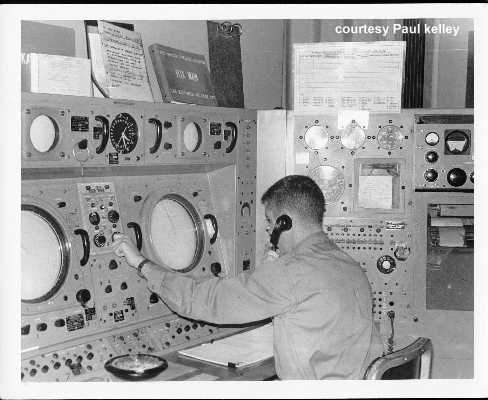
While the overlay was a convenient way of identifying the actual location of any target, using lat and lon was clumsy when trying to report this location. Therefore, while the overlay corresponded to lat and lon, an alphabetic ‘georef’ system was used to identify each rectangle bounded by two lines of lat and two of long in lieu. The whole of the arctic was divided up under this georef system and each rectangle of space on the scope could be identified by 4 letters. Within the rectangle two further digits would be used, much as on Ordnance Survey maps, to indicate E-W location and N-S location within the rectangle. So, with 4 letters and 2 digits a target’s location could be pinpointed to within a mile or less.
When a target appeared the convention, as I mentioned above, was to wait for 3 x 48 sec sweeps and then submit a track report to the Sector Controller. Such an initial report would look as follows:
@@XX Station ID – automatically sentABCDXXTarget georef30Minutes past the hourSW Heading1Qty of target(s)1 Altitude – in this case 10000′ (a guess)2 Speed – 200 knotsX or FX = Initial, Amending or Follow-up report
F = Target Faded
The 14 knobs on the Lower Panel were rotated to indicate the requisite information. The first 6 knobs were for the georef, the next two for the time, etc. Once all the knobs were in position the transmit button to the right of the knobs was depressed and the message was sent to the Sector Controller with a copy printed on the RO (Receive Only) TTY to my right.
Hidden within the console was a whole mass of TTY type equipment and hundreds of relays. The whole process of message transmission was entrusted to this electromechanical maze which I undertook to figure out later on – more later.
When the controller received an initial tracking report he would then contact the reporting site on the party line to request further reports at 5 or 10 min intervals depending on the traffic type. He would have to-hand all civil and military flight plans, filed prior to departure with NORAD, for all aircraft intending to penetrate the DEWIZ – Distant Early Warning Identification Zone in any direction, N-S or S-N, and then correlate reported targets with the flight plans.
All aircraft planning to penetrate N-S had to do so within 10 minutes and 15 miles of their planned penetration. If they failed to do so, and did not refile en route, they would be reported to NORAD and rude words would be exchanged with their companies, or something like that. For all civil flights and MATS (Military Air Transport Service) flights the relevant flight plans were sent via TTY direct to the Sector Controller. For the SAC (Strategic Air Command) B-52 flights the flight plans were sent encrypted and therefore yours truly had sight of them before the controller. This was the only case when a console operator knew in advance of the time and penetration point of a flight. Otherwise we were all ‘blind’ which meant – pay attention my son.
THE ‘DESK’
On the flat surface in front of me is the log in which I would enter all conversations and track reports during my shift. Examples of these are in my training course binder. I also had purchased a long stemmed Churchwarden pipe as well as a real monster with a 2′ long stem and huge bowl. I could fill this up and, quite comfortably rest the bowl on the desk while puffing away.
HERE ENDETH CONSOLE LESSON 1
You will be relieved to hear that that ends your tour of the console – for the moment.
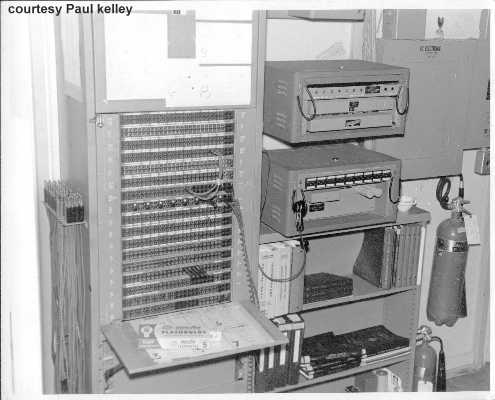
Directly behind the console Radician the Surveillance Room was the Master Patch Panel shown in the photo above. This was a manual way of rerouting any of the lateral voice and TTY circuits to spare channels should we have a failure. We seldom had to use this as the FRC-45 was very reliable. The top of the two horizontal boxes to the right of the MPP was the equipment alarm system with an indicator for each equipment room. Each equipment room had its own alarm panel for all the kit installed therein. If a unit failed it would activate the corresponding alarm on the panel at the entrance to that room and the light and buzzer for the room on this unit. The console operator would then page the maintenance radician telling him to go to the faulty room. Upon entering he would check the room alarm panel which would identify the faulty kit, cancel the alarm, switch over to the backup kit, notify the console operator and then get on with sorting out the problem. All of this would be meticulously logged every step of the way – maybe this is where I picked up the ‘logging’ virus?! I can’t recall what the lower unit was for but I think it was for voice communication with each of the equipment rooms.
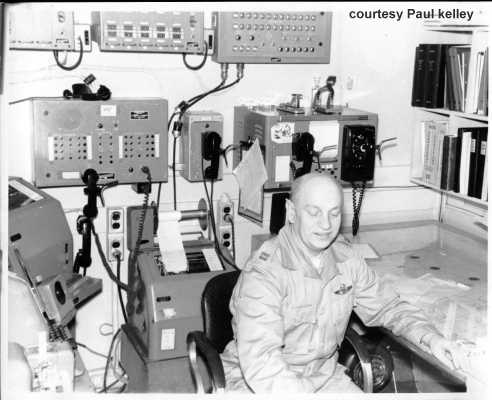
USAF Captain George Nicoloff.
THE SECTOR CONTROLLER
There were 7 military officers at the Main Site. 5 were RCAF Flying Officers and Flight Lieutenants and two were USAF liaison – Captain George Nicoloff shown here was one of the latter. Their boss, an RCAF Squadron Leader (one of the 5), didn’t stand shifts in the Data Centre except if one of the others was ill.
George had been a violinist with the Boston Symphony Orchestra before taking up flying C-124 and C-130 cargo aircraft. I was never clear as to how that transformation came about or how he came to be posted to the DEWline.
He is seated in the data centre which is located just beyond the surveillance room in the same module and separated by a sliding opaque screen to keep the light out of the surveillance room.
On the table under his left arm is a map of the entire FOX Sector with all the georef coordinates superimposed. He would keep track of all traffic by making notes on the plastic over the map. The three large dark circles beyond his arm represent CAM-4, CAM-5 and FOX Main. FOX-1,2,3 are off to the right of shot. The RO TTY behind him is where the tracking reports would appear when sent from any of the sites in the sector. The other two TTY’s to the left of shot were his rearward communications with NORAD via the IS-101 system. This is where the clear text flight plans would arrive. The panel on the wall that looks like the comms panel on the console is just that. It is his equivalent and enabled him to talk with all consoles in the sector.
ANOTHER BUT CLEARER VIEW OF THE CONSOLE
As you are now an expert on much of what you are looking at I will concentrate on the few things I didn’t cover on the photos shown below.

CORRECTIONS/ADDITIONS TO CONSOLE NARRATIVE
First, a few things that have come to mind since. I think I have remembered what was behind the little glass door to the right of the barometer and my head in photo 2. It was a barograph. Essential for barometric pressure record keeping and reporting on all sites without a DOT Weather Station but optional here. We dutifully changed the paper roll every 24 hours but I don’t recall what we did with the recording.
Also, the 3 toggle switches to the left of the telephone (fully visible in photo 1 but here all but obscured by my right shoulder in photo 2) I think were for driving the Telefunken recorder but I am not sure. Finally, the plastic sheet above the weather instruments for recording aviation weather is now legible with the aid of a magnifying glass. Note also, the tissue wadded up in the right handle of the right hand lower beam scope. We would write aircraft ID and the like on the scope in grease pencil and erase the scribbles with this when no longer required. Now to the main differences between photo 1 and photo 2 – the ‘stuff’ on top of the front of the console above the clock.
EQUIPMENT MAINTENANCE DOCUMENTS
The binder on the right is the Equipment Release Log. An entry was made in this whenever any equipment taken off line for preventive or corrective maintenance and the backup units switched into prime mode. Another entry was made when full service was restored.
The white rectangular book to the far left contained blank DEWline C&E Reports. One of these was filled in whenever PM or CM was done on piece of equipment identifying the fault, if any, and the parts used to correct it. These were left for the Lead Radician to process at the end of each shift. In this way every piece of equipment had a log of its entire service history. This, in turn, would indicate any trend towards repeated malfunction and possible need for major overhaul or replacement.
Now for the interesting bit.
DR. STRANGELOVE AND THE ‘GO’ – ‘NO GO’ MESSAGE
The Background
As I mentioned earlier, all SAC B-52 flight plans arrived in the Comm Centre encrypted and, whenever this happened, I had to drop everything (or get roused out of the sack if I was off shift) and get them decrypted ASAP. These flights originated from various SAC bases around the US but, in our area, most of them came from Westover AFB near Springfield, Mass. In the parlance, Westover was Nose Control and all the flights were designated Nose xx. All these SAC B-52’s had the bomb on board and their mission was to fly up to one of several points north of Baffin Island and over Ellesmere Island (77N latitude roughly) and spend the bulk of their 12 hour flight orbiting this point awaiting instructions before being replaced and returning to base.
The Noah’s Ark Message
Once every 24 hours all the military controllers at the 6 Main Sites on the DEWline would be given a coded message by NORAD to be broadcast by all the sites in their sector. The target audience was any B-52’s in the area. The message would be sent to all 6 controllers simultaneously. They in turn would get on the party line to all the consoles in their sector, give them the message and standby for confirmation from each console.
Each console operator would grab the plastic covered message sheet (above the clock in photo 2 above) and write the message in crayon on the long line at the top of the sheet and also about 2/3 the way down the sheet in the broadcast section. In this case it was ‘Silver Cup Charlie’. He would also write, in the top section of the sheet, the Date-Time Group (DTG) given to him by the controller in the format: ddhhmmZ – day-hour-minute and the Z meant Zulu time or GMT which all military installations used. In this case it was 180610Z. Finally he would write in the authentication code given to him by the controller, in this case ‘KP’ or kilo papa.
He would then grab the grey book (behind the C&E Report book on the left top of 2-1 – the one with ‘KA’ just visible. In it were the KAA-29 one-time pads of voice authorisation codes. There was a two letter alphabetic code for each 1 min period of time covering about 3 months. He would check ‘KP’ against the DTG or 180610Z and, if ok, verify to the controller that he has accepted the message.
Once all 29 console operators had received and accepted the message the next stage was for each, starting in the west and working east, to broadcast this message blind for the benefit of any B-52 traffic in the area.
Transmission would begin in POW Sector and the station furthest west, LIZ-2, would be the first to go. The POW controller would be on the party line with all his consoles following proceedings very closely. When LIZ-2 had completed transmission he would buzz the LIZ-3 console and LIZ-3 would transmit, then POW Main, POW-1 etc to POW-3.
When POW Sector had finished the Military Controller would pass the ball to the BAR Controller at BAR Main who would repeat the process for his sector, from west to east, and then transfer to CAM Sector, then the same again and on to FOX Sector and, finally DYE Sector. There was some sort of ‘lottery’ among the military controllers to be won by the sector that completed their transmissions quickest. FOX won on more than one occasion.
When he knew it was about to be his turn, each console operator would enter the current Date-Time Group (in this case 180628Z) in the broadcast or lower section of the message sheet. T hen, for that minute of that hour of that day he would consult the KAA-29 sheets for the two letter authentication code and enter that on the message sheet below the DTG, in this case ‘TA’ or tango alpha. He was now ready to transmit blind when his turn came. When, sitting on the console at FOX Main, the Controller would alert us to a forthcoming Noah’s Ark message and the console operator would do as I outlined above. When he received the buzz from CAM-5 accompanied by ‘Over to you FOX’ the message transmission would begin on UHF frequency 236.6 mhz – the one used by military traffic. To save your eyes, the actual message on the message sheet in photo 2, the most recent blind transmission to have been made, is the message on the lower part of the sheet after ‘A’ and is as follows:
‘Skyking, Skyking this is Staghound this is Staghound, do not answer do not answer, break, break – Silver Cup Charlie – Time is 180628 Zulu – Authentication is Tango Alpha (TA)
Then he would repeat all of the above again and sign off with ‘Out’ at which point he would buzz FOX-1 and say ‘Over to you FOX-1’. Et cetera as above and, when DYE Sector had finished, the broadcast of the Noah’s Ark Message was complete.
THE MESSAGE FORMAT
The ‘NO-GO’ message, as you have seen, was in the format of two random words and an alphabetic character phoneticised. Although, happily, I never saw a ‘GO’ message I understood that its format would be three phoneticised letters.
THE ‘MESSAGE’ AND NORMAL B-52 TRAFFIC
Although I was in the unique position of knowing roughly when the northbound B-52’s would appear it was still always a bit of surprise because, quite often they would call in before appearing on the scope. The UHF receiver lamp would light up and a voice, usually with a heavy southern accent but rendered hollow sounding and rasping due to oxygen masks, would come over the speaker and the exchange between us would run something along the following lines:
- B-52: Hall Beach radio, Hall Beach radio this is Nose 42 on 236.6, do you read? Over
- HB: Roger Nose 42 this is Hall Beach radio reading you loud and clear go ahead
- B-52: Roger Hall Beach this is Nose 42, do you have any traffic for me? Over.
- HB: Affirmative Sir. Please standby one.
- B-52: Roger, Nose 42 standing by.
I would then enter the current DTG in the lower section of the message sheet with the current message on it, consult the KAA-29 codes sheets and then enter the corresponding authentication code for the DTG. I would have about 30 sec at the outside to do this. Taking longer than this would result in comments being filed with NORAD if the crew of the B-52 wasn’t in a good mood. Those guys were highly programmed professionals and weren’t inclined to give you much slack. This was serious business no matter how you looked at it.
I would then climb onto 236.6 again and transmit a slight variation of the previously broadcast Noah’s Ark Message:
HB: Nose 42, Nose 42 this is Staghound, this is Staghound – message is Silver Cup Charlie – Time is 180628 Zulu – Authentication is Tango Alpha (TA)
Then, as with the broadcast message, I would repeat the entire message and authentication again and close with ‘Out’. After a pause of a few seconds a response would come back along the lines of:
- B-52: Staghound this is Nose 42, authentication complete, thank you and good night
And thus the lads would cruise on their way towards orbit Juliet or wherever not to be heard of again by us as they would generally return southbound somewhere over the DYE sector.
OTHER MILITARY AND COMMERCIAL TRAFFIC – PLUS FUN AND GAMES
MILITARY
We would frequently get Military Air Transport Service (MATS) aircraft, usually out of Dover, Delaware, northbound for Thule. These would be C-124’s or C-130’s carrying cargo and personnel. These guys were the ‘truck drivers’ of USAF and a lot looser than their SAC counterparts. We would chat quite a bit with them.
Bob Hope
On one occasion when I was on the pilot said they had Bob Hope and an entertainment troupe on board. I said I didn’t believe him. He said, wait a minute. He got Bob to come to the cockpit and I had the pleasure of matching wits with the best in the business for about 3 minutes. I managed a bit of repartee but soon dissolved into laughter at his remarks. Flt. Lt. Finch (I think it was he) was on duty in the Data Centre that night and I shouted to him to come into the console room while they were fetching Bob. He couldn’t believe it either. Let’s say that, if it wasn’t him talking to us, it was a damn good impersonation. It was all a bit of light relief on an otherwise quiet night.
Phone Calls Home
On several other occasions when I was talking with the pilots I indicated that I came from New Jersey and would they mind making a phone call to my home when they got back to Delaware. No problem. My mother received at least two such calls that I can remember informing her that Number 1 Son was thriving in the arctic. She was quite taken aback on the first one wondering why a USAF officer might be calling her. On the second one she had the drill down pat.
COMMERCIAL
We had quite a few commercial flights passing through at regular intervals. When you came on shift you pretty much knew, after a while, that such and such a BOAC or KLM flight en route to Los Angeles or Edmonton would make an appearance. They all operated on VHF (122.2 mhz) and, with the kit they had on board, would boom in over the speaker when they made their DEWIZ penetration report inbound or were just calling for a position check outbound. Generally we would make a deal with them that, in return for 10 min position fixes they would bring one of the stewardesses into the cockpit to have a chat with us. On one evening, Glynn was having a quiet time in the Comm Centre so came down to the console for a bit of diversion. A KLM flight from Edmonton to Amsterdam was overhead and I prevailed upon the Captain to do the usual. Glynn was going out on R&R shortly and would be passing through Amsterdam en route to Vienna. When chatting with the stewardess he said he would meet her for coffee in Amsterdam the following week – and he did! So much for amusing interludes in the arctic night.
UNKNOWNS
I only ever had one peculiar track that I could not account for. With nothing going on one night shift, a faint target paint appeared in the SW on the lower beam. I checked the upper beam and the target was more distinct. Then another paint indicating the target was heading NE at about 500 mph. Then one more faint paint on the upper beam and nothing. I reported this to the Data Centre. The controller had no flight plan that corresponded to such a flight. It was coming from the S so no great problem – but what the hell was it? After discussing it for a few minutes we guessed it might have been a U2 climbing to 60000′, well above airways and at the limit of our capabilities. They never filed flight plans to my knowledge as they flew so high and we assumed he was on an ‘air testing’ mission sampling the upper atmosphere after Russian nuclear tests. All guesswork on our part though.
TRAINEES
Unbeknown to the new guys that arrived on site, in the Data Centre was a simulator used to paint targets on the scope of the console and give the guys practice in tracking and reporting. We were all introduced to it in the same way. You’d be sitting there watching the lower beam on a quiet shift, usually your first official one, accompanied by one of the more experienced radicians. He would take to wandering around, going in to the Data Centre to chat with the Controller or whatever. The point was that his occasional absence was not worthy of note – he was there or thereabouts should he be required for advice.
Then, during one of these absences, a paint would appear on the northern part of the screen above the DEWIZ. OK, no problem, the new guy would make a report after three paints as per his training. But then the second paint would appear and its distance from the first would indicate a speed of circa 1000 mph. The experienced radician and the controller would just be sitting in the Data Centre waiting for the shout to go up from the console. It was fascinating how different guys reacted. I certainly shouted for his nibs to return when he did it to me. The problem was that the Controller was in on the whole thing demanding 2 minute tracks and making comments like ‘possible bogie’ etc. It would really get the juices flowing for the new guy. I soon caught on to the scam, as all the others did, but it didn’t reduce the pleasure of inflicting the torment on the next new guy to arrive!
Here DOES endeth the lesson on the console – I’m sure you’ll be happy to hear. Now for a quick look at the radar room.
THE FPS-19 RADAR ROOM
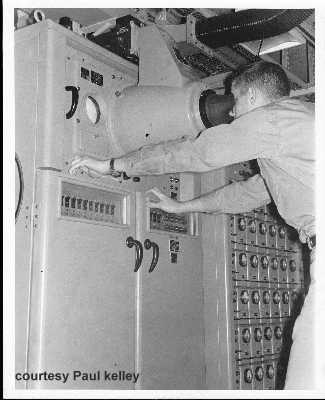
In this shot I am in the Radar Room adjacent and immediately to the E of the Surveillance Room. What you see is the actual radar receiver for the lower beam but the big scope, which is remoted to the console, is covered by a hood. The lower beam transmitter is to my far right and the corresponding units for the upper beam behind me.
As I mentioned earlier, we could, if required, take a picture of the radar scope at intervals of 1-10 sweeps as desired. The black box attached to the top of the hood is the camera and hence the need for the hood. To peer in I simply flip a lever to open the viewer and see exactly what appears on the console.
The multiple units to the lower right are the radalarm units. As I also mentioned, if these are switched on six concentric circles at increasing distances from the centre appear on the scope. Any target penetrating one of these circles triggers both a an audio and visual alarm to get the console operator’s attention. Seldom used as we were always eyeballing the scope.
ADDITIONAL PHOTOS
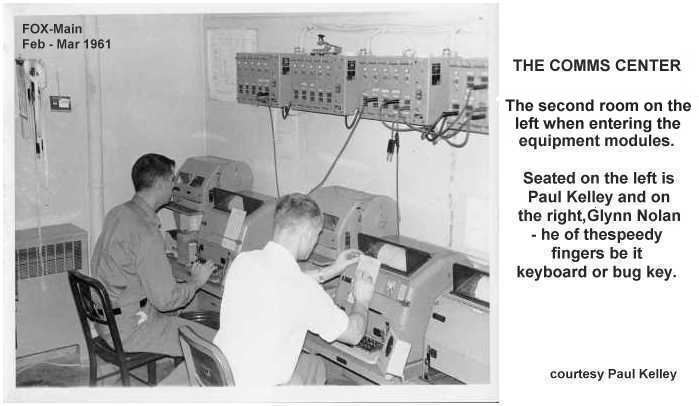
The Communications Center.
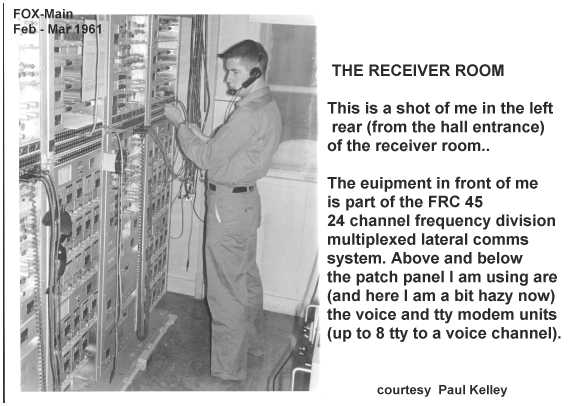
The Receiver room.
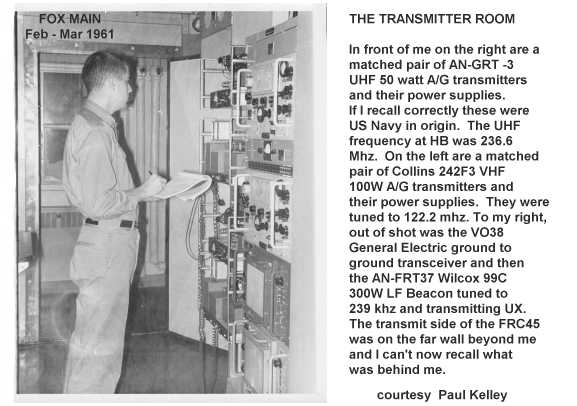
The Transmitter room.
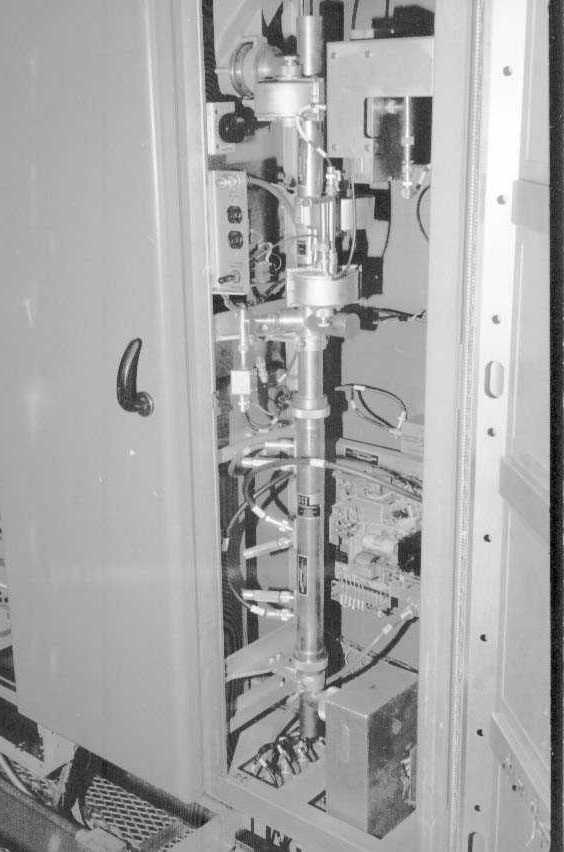
The FPS-19 Radar Transmitter Cabinet.
Please forward your comments to Paul Kelley at: kelley.lleine@gmail.com.
Comments & Clarification
By Clive Beckmann
Paul, you mention in several places that you fail to remember what some of the console switches were for. I’ve included (to the best recollection of my rapidly failing memory) some comments about these switches as they were configured in the Alaska Sector:
1. The plastic panel next to the barometer originally contained a pen recorder that functioned with the fluttar radar going east. There was an identical panel on the left console for the fluttar radar going west. It is very possible that after deactivation of the I-sites, a pressure recorder was mounted inside. Since we had a US Weather outpost at Barter Island, we were not required to have local recorders in Alaska.
2. The controls (starting on the bottom) on the slim panel to the left of the barometer are: a. Main A-C circuit breaker for the console!! It was fitted with a long slender bolt which held it in the ON position. This was added after it became obvious that accidental console shut-downs would continue to occur without it.
b. Power switch for overhead room lights (on the left console, I think this was the overhead U-V light power switch).
c. The top two knobs were dimming controls for console indicator lamps and for console indirect room lighting.
3. The 2-11-1 channel switch row was evidentally configured differently in Alaska: The first two were for mobile radio channel, only the first was used. The next 11 were all the UHF/VHF/HF channels. The single one to the right was the LF Radio Beacon channel.
4. The 6-3 row of channel switches, in the 3 group, the left was the PBX, the center was the station P.A. and the right was the on-station order wire system. Each equipment room, plus several selected locations (chow hall, hangar, runway apron shack, etc.) had a handset on an on/off hook cradle. No dial was included.
The order wire system allowed anyone at the selected locations to lift the handset and automatically be connected to the console operator. An additional feature was that the console operator could manipulate the console channel keys such that the caller would be patched into the mobile radio channel or an air/ground radio channel. The caller then used the PTT switch in his handset to do a two-way conversation with an aircraft or mobile unit.
5. As Paul stated, the bottom pairs of toggle switches were the party lines East and West with a signaling button for each site in the sector and the data center. The black buttons keyed a selective tone generator which would signal only one of the many sites tied into the common party line voice channel. Exception: One of the buttons keyed all sites. However, in Alaska we shut down the data centers early in the game, about 1962-63 time frame, and the Alaskan Norad Control Center (NCC) at Elmendorf AFB in Anchorage took over data center duties. Because of this the party line switches were configured so that the left set (only the left switch of the two, and upper left button were used) would signal all sites in the sector to the west of you. The right set (only the left switch of the two, and lower right button were used) would signal all sites in the sector to the east of you, including the NCC.
6. In Alaska, the key ring hanging on the knob was for night access to the supply facility which was only manned during the day.
7. On the panel containing the six vertical radalarm lights, the inverted “U” device was a synchro indicator that showed radar beam elevation. Directly below that you see two lamps with a toggle switch under them. The switch selected either “pencil” or “cosecant” radar beam antenna configuration. It is this switch that caused movement of the antenna vanes that interleaved with the fixed vanes on the lower 25% of the antenna reflector up in the radome. The lamps indicated either pencil or cosecant selection.
Return to the DEWLine – 50 Years Later
by Brian (Simon) Jeffrey
On July 29, 1960, 19 year old Brian (Simon) Jeffrey stepped off DC-4CF-IQM at Hall Beach NWT, FOX Main, to begin a three year career as a radar technician (Radician) in the FOX Sector of the Distant Early Warning Radar Line (DEWLine).
Fifty-two years later, July 2012, 71 year old Brian Jeffrey stepped off ATR-42 C-FIQU to return to Hall Beach NU, still FOX Main, to fulfil his dream of physically strolling down memory lane.
The youngest Radician to be sent to the DEWLIne in 1960, Brian is probably the oldest DEWLiner to make a return visit.
The Dream
It started innocently enough, a simple dream to return to FOX Main (Hall Beach NU), the place where I had my 20th birthday, 50 years after the fact. I would be 70 in 2010.
It was 2009 when the dream started. That gave me less than a year to make it happen. The DEWLine had morphed into the North Warning System (NWS) and I had no contacts, at any level, within the Nasittuq Corporation who managed the NWS or the Government to make this thing happen. By 2012, the dream had all but died, or so I thought.
The dream came about because for the past few years I had been in regular correspondence with fellow DEWLiners Paul Kelley in Wales UK and Lyall Lalonde in Winnipeg. Lyall and I first met at CAM-D in 1960 when he was the sector mechanic and I was the station radician. Our paths crossed from time to time while we were on the Line.
On the other hand, Paul and I were both Radicians at FOX Main around the same time but neither of us remembers the other and we didn’t connect until 2005 or so. Since then, we’ve been in fairly constant communications while he was documenting his time on the Line. He has an incredibly detailed tale to tell.
It was because of these contacts that I began to get the urge to “go home” again. In fact, my first home-away-from-home was CAM-4 Pelly Bay. Until I arrived at CAM-4 in August of 1960, I had lived at home with my mother. I was now on my own and out of the nest for the first time.
Rekindled Dream
Over the years, various people would stumble over my DEWLineAdventures.com or my VE3UU.com websites and contact me with questions and/or their stories of the DEWLine and life in the Arctic.
One such person was Mark Pimlott. Mark lives and works in Igloolik NU, and has for many years. I’m not exactly sure how we first connected but Mark has been kind enough to send me stuff from time to time. It was one of these pieces of ‘stuff’ that rekindled the dream and was instrumental in making it happen.
On May 31, 2012, Mark sent me an email with an attachment showing some interpretative panels that were proposed for installation at Hall Beach. The panel included several quotes from Paul Kelley so I forwarded it on to Paul for his reading pleasure.
Then, one day later, I received a second email from Mark containing yet another PDF and this one not only containing quotes by me but several pictures from my web site including photos of yours truly as a young Radician. In his email Mark asked if the Nunavut Parks department had asked for my permission to use my stuff on their interpretive panels. They hadn’t.
The fact that they hadn’t sought my permission didn’t bother me as I was delighted that someone found it interesting enough to use. However, the fact that they had used my material without asking permission opened the door for me to seek their assistance in realizing my dream of visiting Hall Beach.
I sent off an email to the minister in charge of the Nunavut Parks department in an attempt to make him feel guilty enough to bring me up North. While it didn’t work, the gentleman who replied, Cameron Delong, copied Jessica Hallam of the Nassituq Corporation who offered to see what could be done about arranging for a visit to FOX Main, Hall Beach NU facility. The Nassituq Corporation is the organization that managed the Northern Warning System at the time.
The Stars Align
Jessica contacted me on June 13 and let me know that she was the person who arranged things like this and that, “I have never dealt with a request of this nature, but I’ll do my best.”
Complicating my situation was the fact that I had been diagnosed with an aggressive form of kidney cancer in my right kidney and was slated to go into the hospital on July 17 to have the damn thing removed. This severely limited my window of opportunity in that if this visit didn’t happen soon, it wasn’t going to happen at all for me.
On June 18, Jessica had received approval from both the Nassituq Corporation and the Canadian Government for me to visit Hall Beach. The only dates available were July 2-4. As an added bonus, the Nassituq Corporation would provide accommodations, rations, and local transportation while I was at Hall Beach.
All I had to do was arrange my own transportation north which I did within minutes of receiving Jessica’s email. I would leave Ottawa via FirstAir on July 1st, Canada day, overnight in Iqaluit NU, and carry on to Hall Beach on July 2nd.
Like a Child on Christmas Eve
To say that I was excited about the trip is an understatement. I couldn’t have been more excited. I was like a small child on Christmas Eve, full of anticipation and expectations. Was Santa going to be good to me? Will I be allowed into the Electronic Modules where I spent most of my DEWLine work life? What do the buildings look like now? How might they have changed? What has 52 years done to the appearance of the facilities? Is the Emergency Radio room where I operated as VE8SK still there? Might I get to operate the station one last time?
The Journey of a Lifetime (for Me)
For whatever reason, I knew that this trip was going to be a big thing in my life and I was sharp enough to keep a log or diary of the journey. If you want to read the rest of the story, you’ll find it here.
You’ll also find the video of my trip at the bottom of that page. It is a combination of videos and still pictures of my adventure. It’s titled “Hall Beach: Fifty Years Later, An Old Dewliner’s Pilgrimage.”
The DEWLine Family
by Clive Beckmann
Those of us who served during the cold war, thrown together on those tiny sites and only able to leave every six months or so, consider ourselves to be Dewline brothers and sisters — we call ourselves the ‘Dewline Family’.
We worked, ate, and played together, a hundred miles from nowhere in most cases, so our days were much like a regular family in the south. The fact that this closeness is still the case so many years past the demise of the program is testimony to the close-knit relationship we all shared.
There are other programs that have created an association like ours, but none as sincere or long-lasting as the Dewline Family.
Ice-Cap Memories
By Ed Hess
There has to be a great number of us out here who remember very clearly the way things were before satellites became the main vehicles for observation, surveillance and communication. As a RADICIAN, I worked as a surveillance “scope-dope” and fixed everything technical that worked on electricity -from the movie projectors and tape recorders to the humongous AN/FPS-30 search radar and TROPO/MUX systems. We also were plumbers for the Heat Exchangers and waveguide pressurization gear.
I am not sure how many on multiple rosters on the Internet passed through the DEWEAST project. But I am only one who spent several years up there, most of which time was working on the DYE-3 Icecap site in Greenland. I would do it again, although perhaps I wouldn’t stay as long. When I left in July ’65, I was one of a very few most senior technical employees on the DEWLINE (ranked at #20). I had arrived just after the replacement of the last installation engineers at turnkey time.
That experience altered my viewpoint on many subjects. I was there on duty when John Kennedy faced down the Russians on the Cuban missile installations. I was there when John Kennedy was assassinated. We all felt very isolated -even more so than that imposed by the physical distances. Those were dangerous times, and we up there felt the responsibilities which came with the job of surveillance and communication of aircraft movements in that area.
DYE-3 was at about 10,000 ft up on the Iceap of Greenland. My first “controlled crash” landing of that great bird -a C-130 on skis- at that altitude was awesome. When I climbed down onto the snow and looked around, I knew I was in for a wild experience. From my feet to beyond any imaginable distance, there was nothing but flat white snow…! No plants, no animals, no insects, -not even a smell…! My breath was coming in short gasps as I staggered to the “Trackmaster”, and I would be some time becoming accustomed to all this -and more. I was to spend a significant part of my life in one of the most hostile environments on the planet.
The “composite” building we inhabited was 160 ft high to the top of its Radome and housed all equipment, quarters and stores. The only exterior facilities were garages and under-snow-level fuel storage tanks. The main building sat on 8 “legs” and was “jacked up” from time to time….! (To overcome windblown snow buildup) Fuel was replenished once yearly during a several -week chain of flights during the summer. At other times, we got “mail runs” repair parts, miscellaneous materials and food on no real fixed schedule. We had to “make” our water from the all-surrounding snow. The relative humidity inside the building was under 10%, and we had to “snap-off” arcs of static electricity charges on the brass doorknobs at every few steps. There were drinking fountains everywhere and we all carried “Chapsticks”. I lived in a corner room and when the wind blew from the “wrong” side, beer would freeze on my writing table. On those days, I slept in a sleeping bag -with acoustic protectors on- beside a transmitter cabinet.
It was all so unreal.
The fellowship and hard work kept me busy for years, and when I left that incredible place I knew I could never be entirely free of those million indelible and most privileged moments. I never tire of recounting them to the poor mortals about me who never had -or ever will have- the experiences some of us in this community share. It’s all in the past, -an unrepeatable and very exciting piece of history.
How many others remember?
Sincerely, Ed Hess
Nineteen Months in Retrospect – Part One
By Martin Allinson
Forty years on, I still remember the DEWLine with great affection.
Considering that it was located in a barren, inhospitable region, and that it was an all-male environment, that opening sentence may sound surprising.
But I have always considered that the Line gave me back every bit as much as it took.
In fact, all it really took was 19 months of my youth. I was just turned 24 when, in April 1959, I reported to the Columbia Hotel in Streator, Illinois; and I was still only 25 when I departed Cape Dyer for postgraduate studies in the teaching of electronic engineering.
And in the meantime there had been a lot of fun, and the acquisition of a wealth of experience and a hefty bank balance.
CAVEATS I am writing this article (in 2003) for Larry Wilson because my memory has been stimulated by my coming across all the slide photos that I took on the Line. But memory is notoriously fickle, partial, and unreliable. So I will have to end the article, as Victorian invoices did, with the initials E.&O.E.
Those initials stand for ERRORS AND OMISSIONS EXCEPTED.
Sometimes I will have to guess at the spelling of names, and maybe I will have misremembered some of the names. Sometimes I will have a clear (but possibly wrong) memory of an event but get it in the wrong location—and vice versa!. I apologise for all the unwitting errors that there may be in what follows, and to anyone who feels traduced by what I remember of him. As you read, please remember that the words come from the mere fragments of an old man’s memory. The only hard facts are that there was a DEWLine and that, during my time on it, these photos were taken!
GETTING THE CONTRACT. Attending for interview at an office near Edmonton Airport, the Federal Electric Corporation representative gave me an electronics test paper to answer. No problem with that—I had just spent a year teaching the stuff at the Institute of Technology in Calgary. After he had graded it, he started to tell me about the Line. And I got a distinct impression that he wanted my application to succeed. Maybe he was below his recruitment target; who knows.
Anyway, he didn’t make me do the Personality Assessment questionnaire in a race against the clock, as he was supposed to. He said I could take the questionnaire with me, answer it at leisure, and mail it back to him (being very careful and wary, as the graders compared the answers of some of the questions with the answers given to other questions to catch out pretenders). Maybe he was being helpful, or maybe he just wanted to get away early to his golf; who knows.
I spent the whole afternoon and most of the evening on that questionnaire, answering each question only after checking back on the previous ones and forward on the later ones. I came to the conclusion that, whilst I might not really be a normal and well-balanced young male, I could certainly make a good pretence of being one. Years later, it dawned on me that that was all that was required in order to be socially acceptable on the Line.
STREATOR. The 14 weeks at Streator were hard going. Unlike the group that Charles Flynn writes about in “Green Grass Fever”, we were not knowledgeable, experienced technicians.
So they worked us hard and each Saturday morning there was a stiff “do or die” test—score less than 70% twice and you were out.
We lost one of our group after two weeks: 68% on the Weather Reporting course, and 68% on the Electronics Theory Revision course. There was a strong whiff of suspicion that the Streator Management had wanted one failure “pour encourager les autres”. And some of us felt quite outraged as the man who was sacked, Doug Helm, would have made a very dependable radician, especially for an I-site. Doug was about 35 and quite a bit older than the rest of us. His only problem was that he was not so used to studying in Streator Success Mode (i.e. “pack-it-into-short-term-memory-and forget-it-next-week”).
The result was that a core of angry young men resolved that management wasn’t going to get anybody else, and each Saturday morning the seating was carefully planned so that each of the weakest was between two of the strongest and allowed to see their answers to the multiple-choice questions. Where the two strongest were giving the same answer the weak one put in that answer, too; but when the answers of the strong differed the weak one had to guess which of his stronger to follow. Sometimes the weak one got a slightly higher score than both of the stronger ones!.
We even got my room-mate through. And Don really was a struggler. His only electronics studies had been at a night class to prepare for the test for a Ham’s licence and he had nil electronics experience apart from a bit of domestic radio and tv repair knowledge that he had picked up whilst doing spare-time work. Sure, he had six years with British Columbia Electric to his credit—but, if the truth had ever come out, he had been working with them as a bus driver!. After the first day of the week on Electronics Theory Revision he confessed to me that, for him, it was a bit of Revision and a lot of First Time. He had got through the test at the interview because someone in Vancouver had managed to get hold of a copy of the test paper and it was circulating amongst the Hams. I wonder how that had come about—maybe someone else was below his recruitment target; who knows.
I was glad to help Don in repayment for him introducing me to private flying. He was a private pilot and had taken me up from Streator’s little aerodrome on our first weekend. And a few weeks later I managed to get their little Taylorcraft back on the grass after my first solo flight.
We finished at Streator at noon on the Friday during Calgary Stampede Week and I was determined to get home for its final Saturday. Don was in a hurry to get home, too. So we chartered a Cessna from Streator to Chicago. It scared us witless to go into Midway amongst all the big stuff. I hopped westward through the night on three red-eye flights and got to Edmonton at dawn to find that there was no flight to Calgary because it was a Saturday. In those days, it was nearly all business executives who flew between Edmonton and Calgary and they didn’t work on Saturdays. And there was neither a train nor a Greyhound bus till evening. So the journey that started with my only-ever air- taxi charter ended with 200 miles of hitch-hiking. But I got to the Stampede—and could hardly keep my eyes open, even during the chuckwagon races.
CAPE DYER. If any landing that you walk away from is a good one, then we nearly had a bad one on my first arrival at DYE Lower Camp. It was a Wheeler Airlines DC 4, and a bloke called Miller landed it (first time) just slightly short of the threshold.
Unfortunately the ground level had been slightly sloping and the gravel for the runway had had to be built up quite thick there. This had resulted in a slope with a gradient of about 5 degrees in front of the threshold.
.
So, as the saying went, it was a down that was no touch. About 30 tons of DC 4 travelling at about 120 knots hit the slope with an almighty bang, bounced up (to 100 foot, the onlookers said) and then dropped down again with an even bigger bang. I thought that second landing would bring the oleos right up through the wings but, miraculously, there wasn’t even a burst tyre.
However, bad things had been done to the structural integrity of the wings (including three fractures of the main spar, it was rumoured). So both the DC 4 and Captain Miller ceased to serve with Wheeler Airlines. Permanently for Miller, but only temporarily for the DC 4. After some repairs, a special approval for one flight with no load was obtained and a volunteer Wheeler Airlines crew came up to fly the plane gently back. By then I was on shift at DYE, and I happened to be the console operator when it left. The Captain gave me the longest, most detailed flight plan that I ever had to copy. No mere “Great Circle Route, Cape Dyer to Montreal” for him. He was going to fly exact airways, point-to-point, and was making sure that Search and Rescue knew exactly where to look for him if a wing started to droop and he had to do a wheels-up on the muskeg. And his track south from DYE was quite a zig-zag as he eased the delicate patient around and avoided any cloud that might be turbulent. Next day, I enquired at the Comm. Centre and learnt that they had made it to Dorval.
DYE MAIN Those first few weeks at DYE MAIN went well (though there was better to come). The work was varied and enjoyable and the summer weather was mostly good; so days off could be spent getting in some walking along the cliffs and to the snow and ice caves. Soon the Sealift could be seen on the surveillance radar, advancing through the ice clutter. Days off were subsequently spent at the beach taking photographs and giving a hand by driving a 4X4 or a 6X6 from time to time.
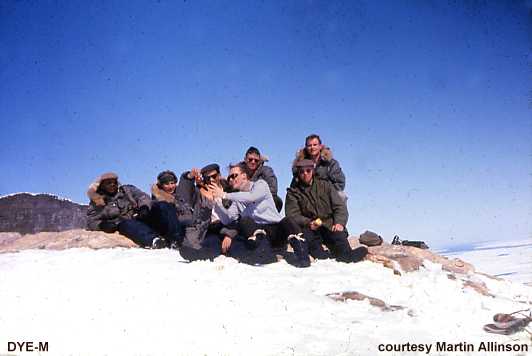
Sunday Excursionists.

TOWARDS THE I SITES Quite soon after arriving at DYE, I had indicated to the Sector Chief, Communications and Electronics that I was interested in the position of Sector Radician (I Sites) when it came available in about four months time. I had figured out that the Sector Rads got to travel about a bit, rather than being continuously on one site, and that only the I Site position was within my youthful limited experience and competence.
Also I was attracted to the I Sites as they seemed less formal than Main or Aux Sites. Their basic, year-round staffing was just four men: Station Chief, one Radician, one Mechanic and a Cook. And the basic buildings were just a short train of modules and a garage. But in summer there were supplementary staff, such as storekeepers, drivers and labourers to help with the arrival of the Sealift , and maintenance workers such as painters. For summer, Jamesway huts were opened up for accommodation and dining.

Module train at FOX-E.
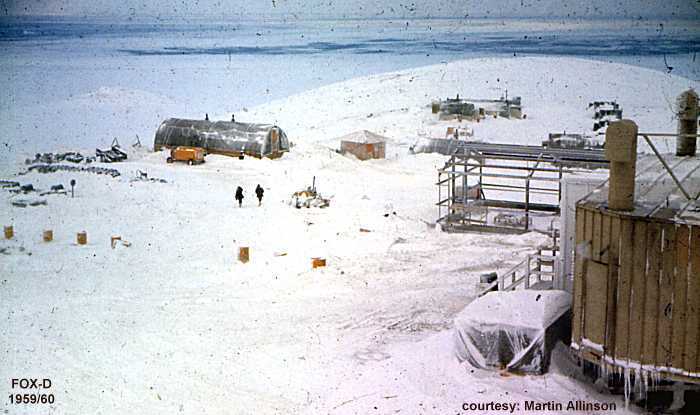
FOX-D Buildings Nov 1959.
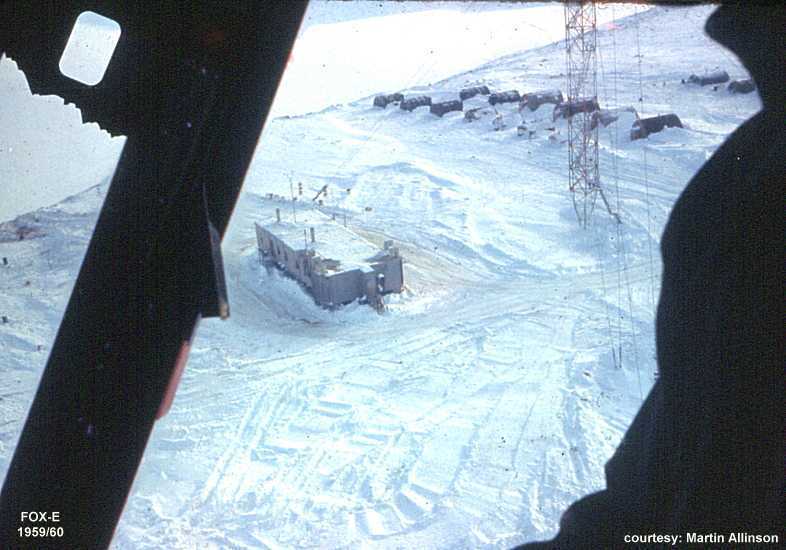
FOX-E from the air.
My interest in serving at I Sites was received favourably, and in September 1959 I was sent to FOX D as an I Site Radician for three months prior to becoming a Sector Radician
FLYING TO FOX D The flight to FOX D was my first in a DC 3. It seemed perfectly routine, until suddenly we were flying in a fiord and doing a descending turn between a little island and a great big cliff. But that was the only way to get into a position to do a safe landing at FOX D.
The terrain at FOX D was so undulating that the only possible airstrip that could be built had to start on the edge of the sea, slope upwards, and end a very short distance inland. Landings had to be uphill and takeoffs downhill. So both arriving and departing had to happen always at the beach end of the strip, and so both involved a U-turn in the fiord. And the fiord had an island in the middle, so the U-turn had to be done just before landing and just after takeoff. Not a place for the faint-hearted, and only permitted with a small load.

Landing at FOX-D.
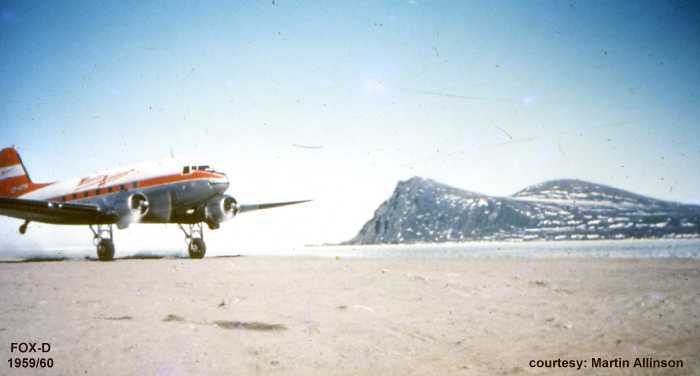
DC-3 at FOX-D.
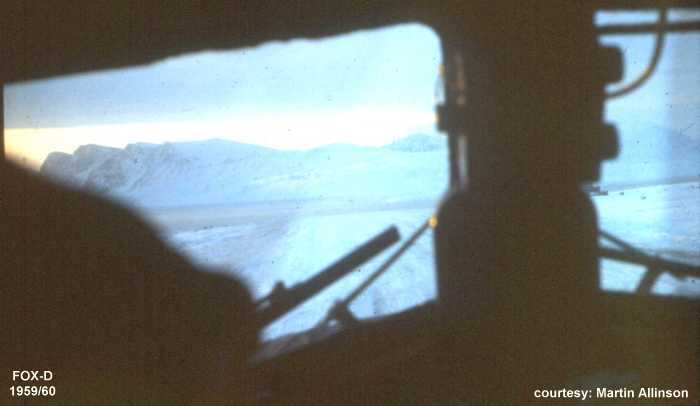
Take off from FOX-D.
Frank Tilzey, the Station Chief, Frank Tilzey, and the other half dozen personnel on site made me welcome and I soon settled in to being radician, weather reporter, ground-to-air operator, medicine man, and general helping hand.

Station Chief, Frank Tilzey.
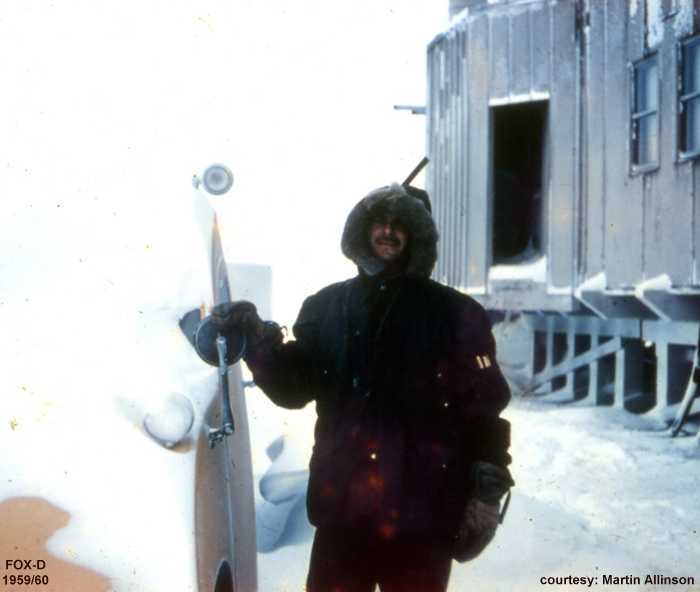
Frank Tilzey.
It is the medical side that remains most prominent in my memory. Because no site would ever be without at least one radician, and because all radicians went to Streator, it had been decided that radicians should look after first-aid etc unless there was someone better qualified available. To prepare radicians for this, they were given a short course (two Saturday mornings!) at Streator and ceremoniously presented with an American Red Cross First-Aid Certificate. Nobody seemed to be concerned that this only helped us to deal with the first few minutes of a situation, and that we might have to cope for days and even weeks before “Second-Aid” could be available.
MEDICINE MAN A diabolical outbreak of influenza in Kivitoo, the Eskimo village at the old whaling station near the airstrip, was my first test. When the head man, Nauyopee sent a messenger to ask for help, Frank took me down there in the snowmobile and we went into the first toopik— a one-room hut made from scrap wood and tarpaulins. Every one of its five occupants was clearly very ill, and all I had to offer was bedside manner and aspirin. Once again, the liar in me came to the fore, and I cheerfully assured them, whilst taking their temperatures and feeling their pulses, that “you are sick, you will be sick tomorrow, sick next day, then ok”. Goodness knows why, but that seemed to brighten them up a bit. I put their clock right by the time on my watch, made sure the clock was fully wound up, gave each one an aspirin, and drew little pictures of the position of the clock hands at the times when they were to take their aspirins. They seemed very reassured by this clear evidence of profound medical knowledge, training, and experience. And their temperatures were all down by a full degree. Praise the Lord for his creation of the Placebo Effect.

Nauyopee, Village Elder at home.
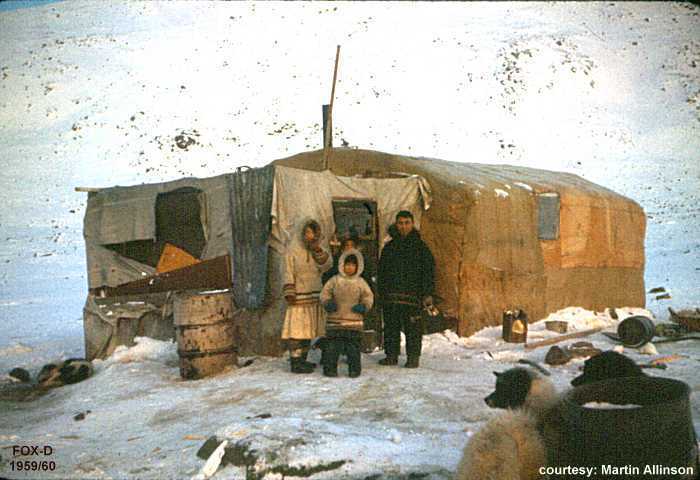
Eskimo family and their dwelling [a toopik].
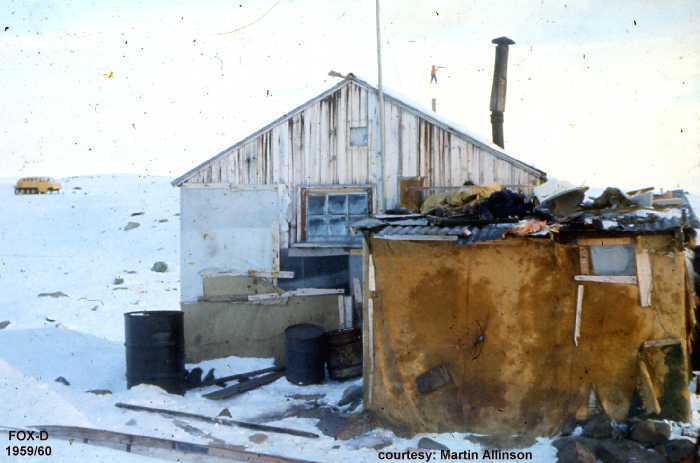
Toopiks at Kivitoo.
But then I noticed that I was alone with my patients. Frank Tilzey had succumbed to the stench of old seal meat in the toopik and was throwing up his dinner by the snowmobile—though he assured everyone that it was my complete and utter bullshit to the Eskimos that had turned his stomach!
We went on to the other toopiks and ended up with about twenty patients. Over the next few days we continued putting on this same air of confidence (or pulling the same confidence trick) and gradually they all recovered.
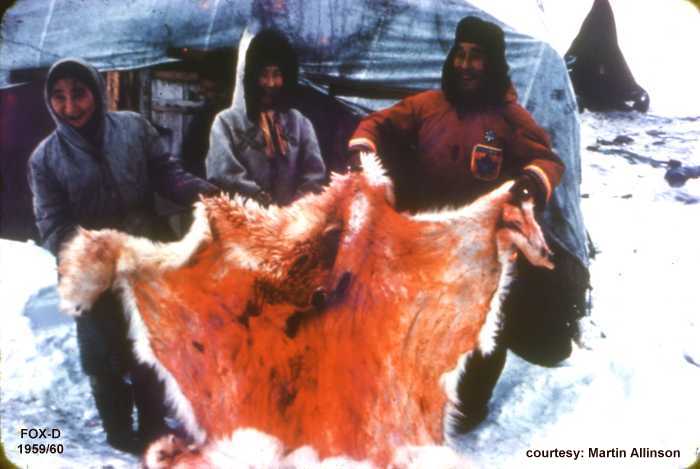
Polar Bear Skin.
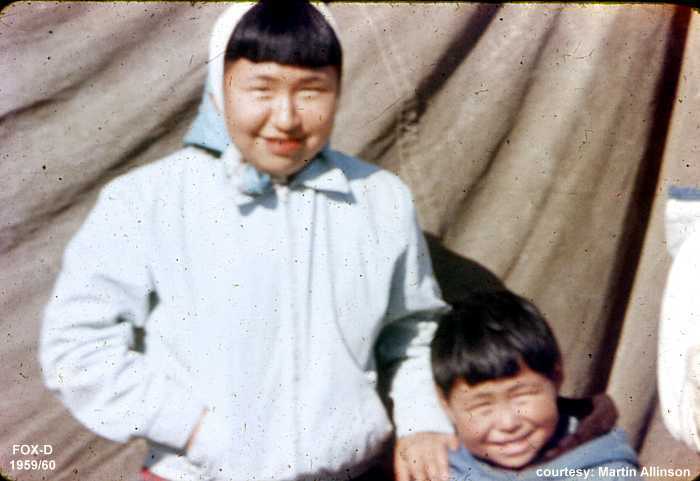
Children at FOX-D.
CONSULTANT OBSTETRICIAN Then came the day when I was just starting back in the snowmobile after taking a weather observation at the airstrip and Frank called me say that a messenger had come to ask for help for the Kivitoo grandmother who acted as midwife. She was struggling with a difficult delivery. My heart dropped. What help could I be to a woman who had delivered dozens, when I hadn’t even seen a childbirth, never mind being involved in a difficult one?. My mother had been a midwife before her marriage, but she was 5000 miles away, and all I could remember was that she had once said that “midwifery is just a matter of helping Nature to do what it is trying to do anyway”.
But I was kept from brooding by ever-helpful colleagues. On the I Sites our only communication link with the outside world was to our neighbouring Aux Sites via the same uhf voice channel that was used for the vehicles. So the Comm Centre operators at FOX 4 and FOX 5 heard that I was getting my baptism of fire. At least their gleeful mock advice kept me fully diverted from thinking about what was to come when I got to Kivitoo.
Praise be, when I got to Kivitoo, the midwife had got the foetus to turn and present itself properly and I only had to be an approving, apparently- experienced spectator.
WHAT A BIG BOIL My next case was easy: a young Eskimo man with a boil that was four inches in diameter on his left buttock. The Doctor who was attached to FOX and DYE Sectors happened to be at FOX 5, so I could talk with him on the uhf. He thought that something that size must be a carbuncle. I wasn’t disposed to argue with a professional whom I had never even met. Anyway, the treatment was the same either way—Epsom Salt poultice of magnificent size, and evacuation to DYE Lower for lancing by the doctor when he got there. There was only one problem. The patient couldn’t sit down in the DC 3. We finally strapped him face down to a stretcher and tied the stretcher to the floor of the plane. And made sure that one of the other passengers had a sharp knife to cut the patient free if the plane had to be evacuated in a hurry. Later that Doctor was to agree that it truly was a boil—and a potential entrant for the Guinness Book of Records.
But then we got a tough case. It happened in mid-December, when my relief had arrived and been phased in, and I was on the manifest for the next plane to DYE Lower.
NURSING, NURSING AND STILL HAVING TO NURSE Tommy Kimmisannee, our Alaskan eskimo bulldozer driver, started on the vomiting and belly pains which are the classic symptoms of appendicitis. The weather was WOXO, so there was no chance of evacuation in the two hours of daylight that we would get that day. Obviously, Tommy couldn’t stay out in his Jamesway hut, so Frank moved into the dormitory and we put Tommy in the Station Chief’s bed in the Station Office/ Dining Room on the other side of the dining table from the Radician’s bed.
The weather stayed WOXO day after day and all we could do was basic nursing and have anxious radio consultations via relay with Doctor Roche, who was also WOXOed over in FOX Sector. Seen from today, it was all so pathetically inadequate— no drips, or pain killers (except morphine injections as a desperate last resort, and then only if immediate evacuation was assured) and only very weak, broad-spectrum, antibiotics. To see your patient tiring with the pain, and gradually dehydrating, is a galling experience.
Finally, after ten days, the weather lifted a little—still stormy, but with enough breaks in the cloud cover for a Dutch bush pilot to say that he would have a go at reaching FOX D. And Doctor Roche was inbound to FOX MAIN, whence a DC 4 would bring him to DYE Lower.
That was an anxious day. I drove the five miles to the strip with Tommy on his stretcher in the snowmobile, so slowly and gently that Frank, whose family were undertakers in Manchester, said he would recommend me to his father as a ‘black car’ driver. To our horror, more cloud came over and the patches of fog in the fiord were visibly thickening. We heard the DC 3 overhead twice, but never saw it. In the semi-darkness, and with only goose-necked oil lamps on the runway edges and one snowmobile’s headlamps and rooftop spotlight on the apron, we couldn’t believe that the plane’s crew could find us. And we were scared stiff that Tommy couldn’t stand much more being moved around.
Suddenly someone shouted “There it is”, and CF-HTH came roaring out of the fog to a perfect touchdown just inside the threshold. Magnificent flying.
The door was opened by a young co-pilot who was white as a sheet. When I commented on his Captain’s superb landing he just nodded dumbly.
Whilst we were loading up, we got the news that the DC 4 bringing Doc Roche had landed at DYE Lower.
With Tommy’s stretcher tied down beside two passenger seats, and his body packed round with sleeping bags held in place by a cargo net, we bucketed off towards DYE Lower.
Later, I heard that DYE MAIN console had passed on a report from DYE Lower of a gust of 54 knots just as we commenced the landing circuit. No weather to be trying to land a twenty-year-old DC 3. I can still see the white knuckles of a French Canadian painter who was in the passenger seat ahead of me, as he clutched the seat frame and prayed and cursed. Was I ever glad to be on the ground and handing Tommy over to Doc Roche.
After putting Tommy on a drip, and confirming that the problem really was an inflamed appendix, Doc Roche decided to take him to Frobisher and operate there, with the help of the hospital nursing staff. The DC 4 that had come from FOX MAIN was waiting to leave for Montreal, and could land at Frobisher enroute. It had to wait a couple of hours for the gusting wind to drop sufficiently for it to go off, and by then Tommy was doing so well on his drip and sedatives that Doc Roche decided that it was best to overfly Frobisher and get him to Dorval and have Montreal General do the operation. All that went well and Tommy was back at FOX D in a month.
Old CF-HTH was known as “Heaven to Hell”. But that afternoon she was hell to heaven for Tommy—and me.
MEDICAL RESEARCH A few days later I met Doc Roche again and we had time for a chat. That was the start of a great friendship and many, many more chats (especially after he discovered 5 gallons of Ethyl Alcohol in the DYE medical stores—we used to add it to orange juice for the purpose of serious medical investigation into the rate of absorption of alcohol by our livers).
CHRISTMAS AT CAPE DYER Now that I was a Sector Radician, I was really just a spare bod. We only had two I Sites and both had competent radicians who looked set for months, so there wasn’t even a training requirement. But being a spare bod landed me with one sombre job.
About nine o’clock on Christmas morning, a hut which was the accommodation for one of the Eskimo workers was seen to be on fire. Several of us went out into the morning darkness, but there was nothing we could do. The fire couldn’t possibly be extinguished and when the roof fell in we could see the young man’s charred corpse on the bed. The Sector Office staff took over and contacted the RCMP, who said that they would send an Officer up on the plane that was to fly from Frobisher to DYE Lower that evening. The Sector Superintendent wanted to be able to give an assurance that nothing had been disturbed at the scene, so a watchman had to stand by the remains. Being spare, I was put on the job from 6 p.m. until about 10 p.m., when the Sector Office people arrived from DYE Lower with the RCMP Officer.
Fortunately, it had been a fine night, though cold. And I had seen the most amazing display of Northern Lights. I had seen some aurora borealis at FOX D, and was to see more at other times, but nothing to approach the brilliance, variety, and sheer continuity of the display during those hours whilst I sat by that young worker’s body in his burnt out hut.
RE NOAH ESTATE There was a sequel to that sombre job. Forty two years later, I had finally got around to becoming acquainted with this Internet thing, and had become hooked on Googling. One evening I put in “Cape Dyer” and, amongst the 1,110 results, I spotted a reference to a page entitled “RE Noah Estate.”. With a shock, I remembered that Noah had been the name of the young eskimo worker who had suffocated in his sleep as his hut filled with smoke.
The case report made fascinating reading. Noah had been one of the first Eskimos to go south for training and take up industrial work, and die and leave a considerable monetary estate. He had left over $26,000 (equivalent to about $1,000,000 today). It included $25,000 that presumably came from Death Insurance. The Department of Northern Affairs needed a legal Judgment to tell them whether Ottawa law or Eskimo custom and practice should apply, and whether Noah’s wife could inherit when her marriage hadn’t been (but couldn’t have been) solemnized by a minister of religion. These were delicate and important issues, upon which the Judge took evidence at Broughton Island (near FOX 5) and considered long and deeply.
The Judge said: “The matter of Eskimo intestate succession does require further study, and much study, and immediate study… the Eskimos and Eskimo rights and customs should not be further ignored”. And, later, “The Eskimos have no treaty!! They have no Eskimo Act!” (in contrast to Canada’s other indigenous people, the Indians). “This court must guard their rights, when it can, and sometimes must write upon a clean slate.”
The money was to be shared equally between Noah’s widow and their baby daughter. And the case became a starting point in one section of Canadian law.
QUICKLY OFF TO FOX E My time back at DYE MAIN came to an early, unexpected end. After a few days of bad weather around New Year the helicopter that served FOX E flew there with the mail, and came back with a hand-written note from George Coffey, the Station Chief at FOX E, to the Superintendent of DYE Sector and the Sector Chief for Communications and Electronics. It expressed a wish for a change of Radician at FOX E, as the man there had taken to eating nothing but a dozen eggs a day, and to spending long periods outside the Modules, practicing his imitation of a wolf howling!. George had sent the note because he didn’t feel that it was a matter to be reported by the uhf radio; all sorts of people, in vehicles and in Comm. Centres, at FOX E, FOX 5, and DYE MAIN could hear what was said on the uhf. Fortunately the man concerned had previously had a lot of experience at Main and Aux Sites, so it was decided that I should go to FOX E as soon as the weather permitted and take over as Radician. Then the man there would transfer to DYE MAIN “in view of the impending shortage of radicians who were experienced in Main Site operations”. That was to be the story, and the four of us who were “in the know” would stick to it. So I got my first chopper flight earlier than expected.
BY CHOPPER TO FOX E The helicopter was an Okanaghan Helicopters Sikorsky S 55 that had been fitted with big balloon floats (photo below). In summer the pilot would fly to FOX E through the mountains, but in winter he always took the “sea route”. The object was always to have the best chance of surviving a forced landing, and of being rescued. In winter the idea was that the chopper could settle on the sea ice and rescue could come by dog sled, or even a small bulldozer. However in summer one wouldn’t want to try settling down among ice floes, and/or into stormy water, in an autogyro landing after an engine failure; so it was the “mountain route” that was used in summer.
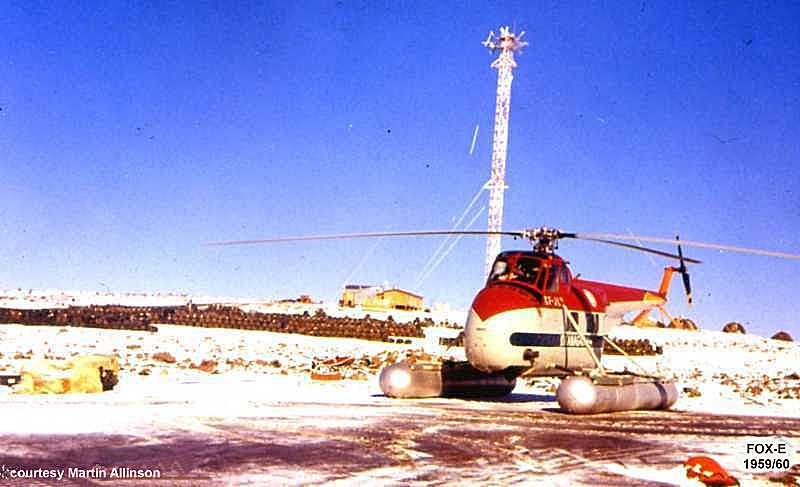
Chopper at FOX-E Autumn 1960.
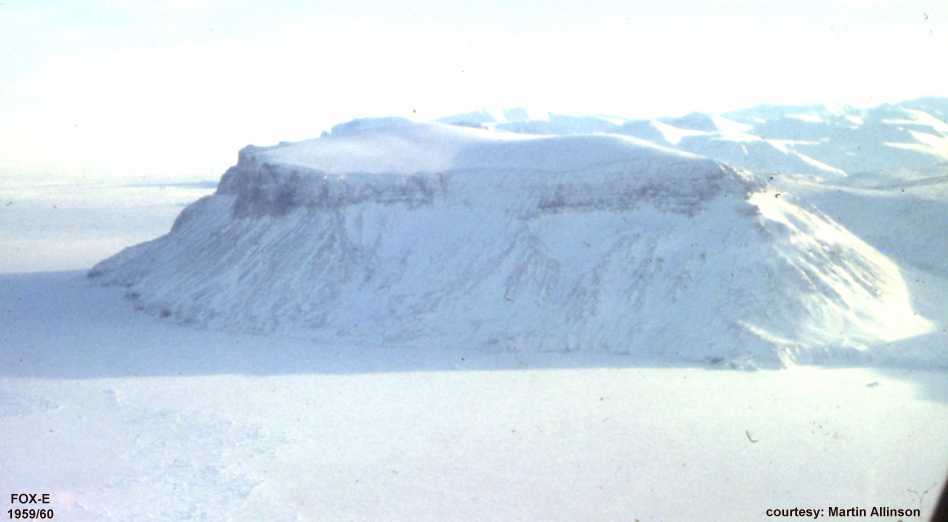
Take off from FOX-E.
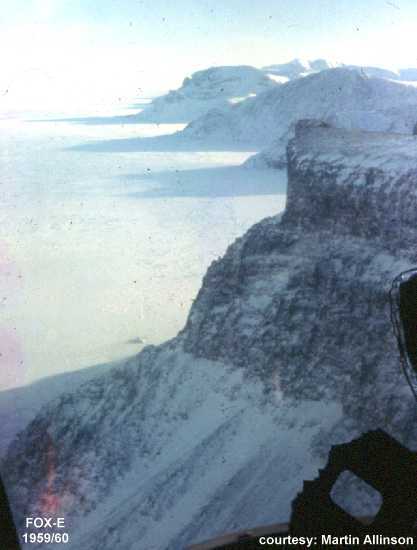
Leaving FOX-E.
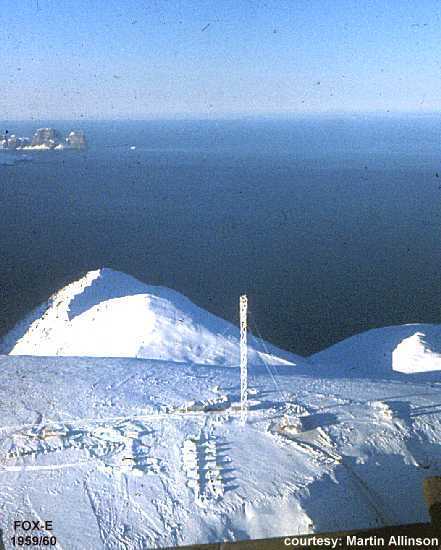
Aerial view of FOX-E from ENE.
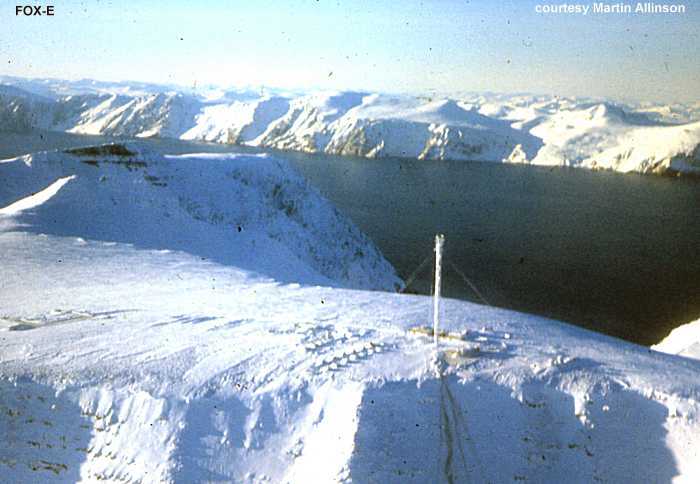
Aerial view of FOX-E from NE.

Aerial view of FOX-E from NE March 1960.
The sea route gave great views of the cliffs on the west coast of Baffin Island. And, after an hour’s flight, there was FOX E looking “out of this world” on top of the cliffs of Durban Island.
FIRST TIME AT FOX E I soon appreciated how much hidden concern the Radician who I was relieving was giving. But the chopper was back in a couple of days and off he went. Then began a very pleasant couple of months even though we got our share of arctic winter weather.

Martin Allinson with dogs at FOX-E.
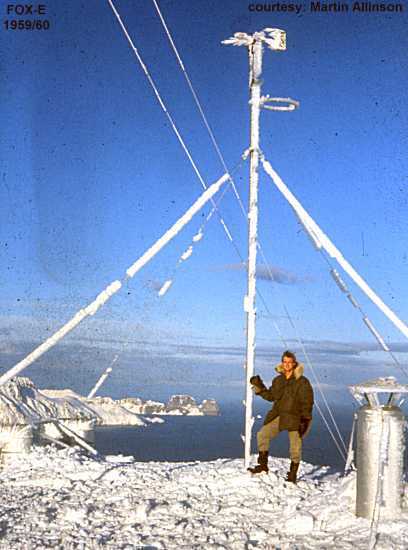
FOX-E in the autumn.
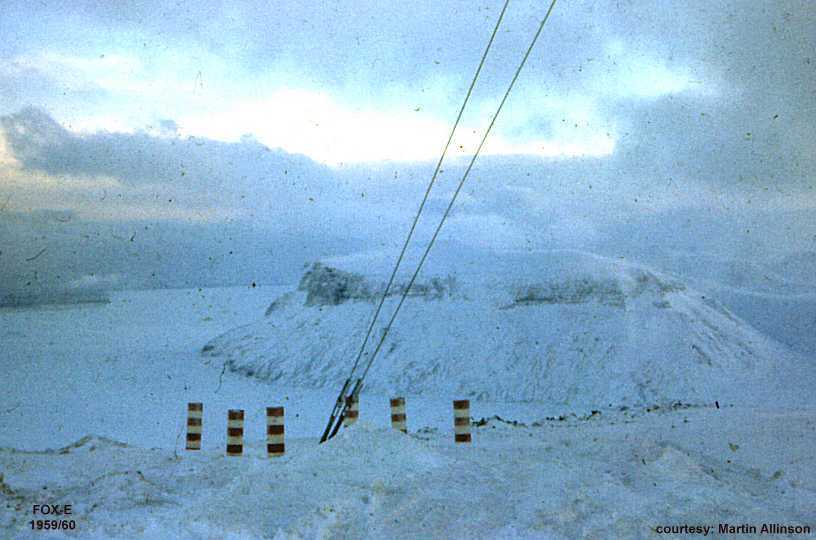
Dirty weather on the sea route to FOX-E.
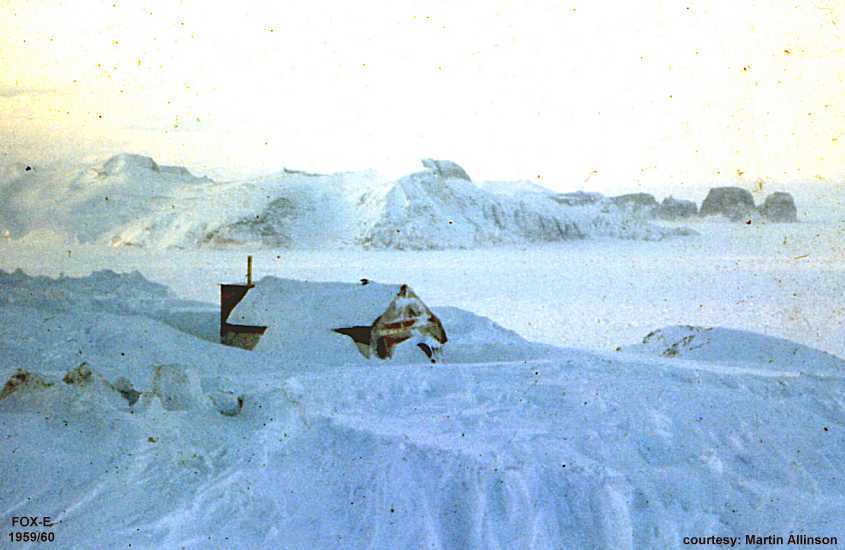
Winter afternoon at FOX-E.
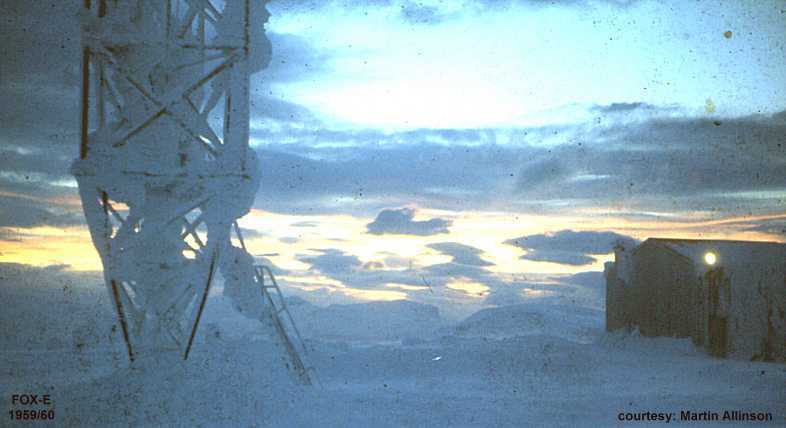
FOX-E Tower & Garage on a winter day 1960.
Martin Allinson
Nineteen Months in Retrospect – Part Two
By Martin Allinson
THE MODULES AT AN I-SITE Through the winter we lived entirely in the Modules. If necessary, we could manage for several days without anybody going outside at all. And sometimes the weather was so bad that the Station Chief would decree that we were all staying in that day. But if it was vital to go outside, say to the Garage to the Standby Generator or to the Store Building for a spare part, it could be done as we had a lifeline rigged from the Modules to the Garage, and one thence to the Store Building. With a length of rope tied round your waist, and a loop from that round the lifeline, it was impossible to get lost (although it could be quite scary, if you were caught by a whiteout).
Each module was about 16 foot by 28 foot and the five of them, joined side by side, made a building about 80 foot by 28 foot that was raised on stilts about 4 foot high.

Looking at the photograph, from left to right, there is the Generator Room (with an emergency-exit door facing the camera), then the Radar Room (with two windows), then the Station Office/ Dining Area/ Kitchen module (with two windows). To the right of the ladder is the Dormitory (with one window) and the main entrance door, and finally the Store Room (also with one window).
The ladder was provided so that the Radician could get up on the roof to climb the low mast and knock the snow and ice off the propeller and moving vane which fed his wind speed and direction meters in the corner of the Radar Room that was his “Air Traffic Control” position.
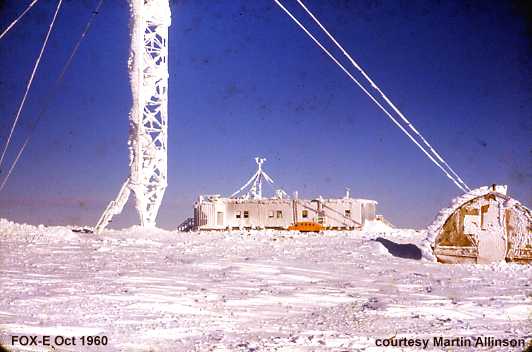
All iced up.

On the roof.
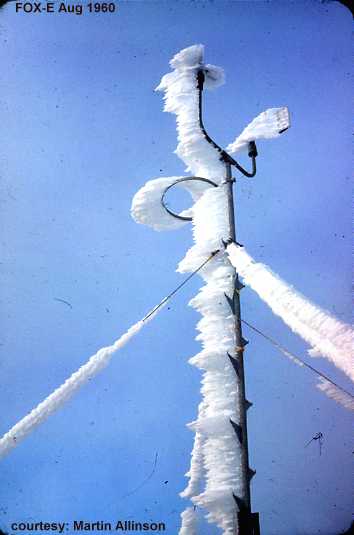
One night’s icing.
INTERIOR ARRANGEMENTS Entering by going up the steps to the fourth module, there was a small corridor, about 12 foot long, at right angles to the main passageway that ran through the centre of each module for the whole length of the building.
The fifth module (to the right as one entered) was devoted to storage: racks of shelves for food, spare clothing and bedding etc. etc., and a big water tank. My only interest in the fifth module was the l.f.beacon transmitter that lived on the shelves there. It simply transmitted a carrier wave that carried a tone that was interrupted so as to form the two letters in morse that identified the beacon. The interruptor was simple in the extreme— a slowly rotating disc with a circle of holes into which were fitted brass pegs (long ones for dashes and short ones for dots). When a brass peg was passing the pickup brush, the tone was transmitted. Simple but effective; and I don’t remember having any trouble from those l.f. beacon transmitters, other than the occasional demise of a vacuum tube. (But the beacon antennas were a pain. As the photos show, their main element was a horizontal wire that needed frequent de-icing and sometimes one night of blowing snow would bring it down).
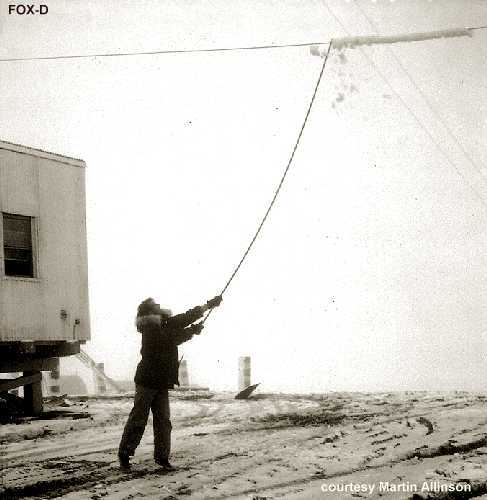
Using the bamboo pole to clear the ice.
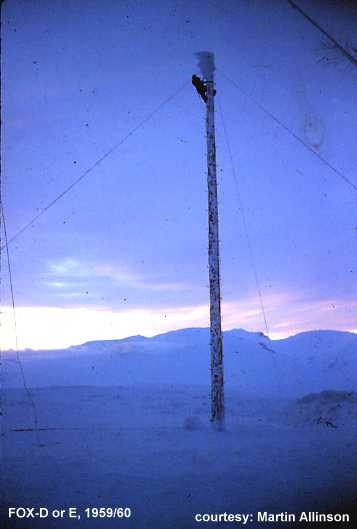
Rigger Repairs.
Turning to the left into the main passageway, one had a cage containing the 60Hz motor-400Hz generator sets and a big tank on the right and the dormitory door on the left. The big tank held the sewage, until it was time to empty it (from outside!) into the Honey Wagon. That was a transit tank on a sled, which was taken to the edge of a cliff, where the contents were disgorged through a wide hose pipe. The photo below shows the brown streaks down the cliff at FOX E (in line with the tower. After use, the Honey Wagon was parked well away, and downwind!.

A lonely existence.
The dormitory contained three sets of double bunks, and was the sleeping accommodation for the Mechanic and the Cook and any winter visitors (such as the Sector Radician, and Riggers).
Through a fire door, one then entered the “living module”. On the right, up a few steps, was the shower room, which also contained the lavatory. The shower room took up about a quarter of the module. The other quarter on the right was the kitchen area with water heater, stove, sink, clothes washing machine, and the Cook’s table.
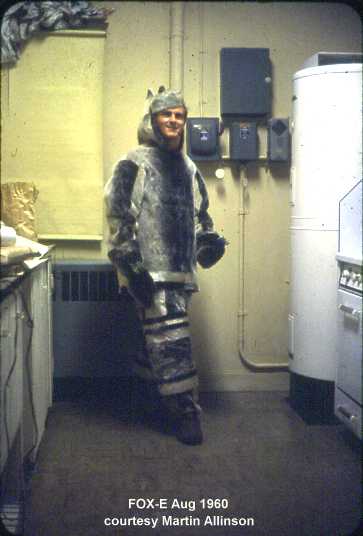
Martin Allinson in the kitchen area.
On the left was an area about 16 foot by 12 foot that contained the Station Chief’s bed, his desk, the dining table, and the Radician’s bed (with the radar equipment alarm buzzer by his pillow).
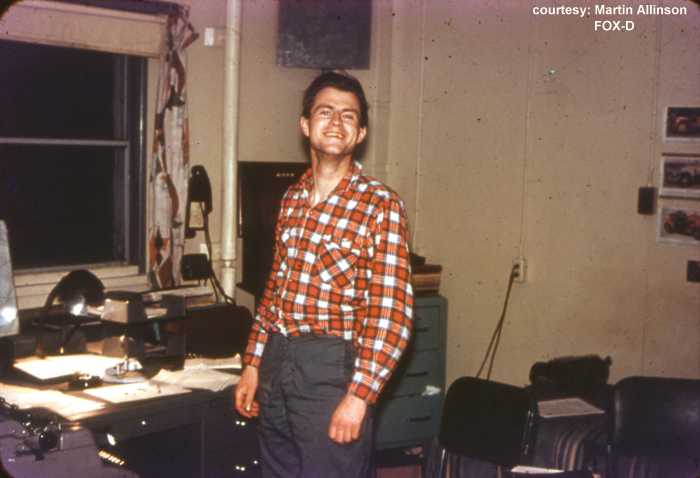
The above photograph shows all the equipment of the Station Office: the manual typewriter (no Del or Bk Sp facility then!), the Station Chief’s desk, and the filing cabinet. The press-to-talk handset on the wall was the Station Chief’s link to the vehicles on site and his only means of contact with the rest of the Line (via the Comm Centres of the neighbouring Aux/Main Stations). Note the foot of the Radician’s bed, behind two of the dining chairs.
In the next module, the Radar Room, one had the Radician’s workbench, storage shelves and desk/comm. centre on the right and the radar transmitters in cabinets on the left.
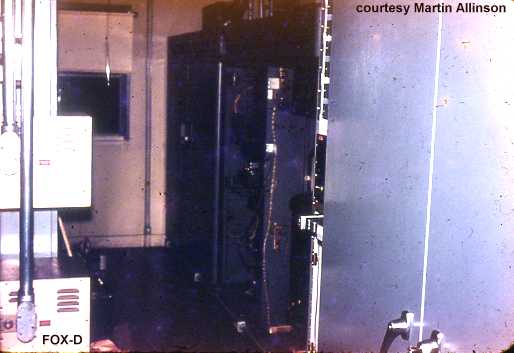
Transmitter cabinets.
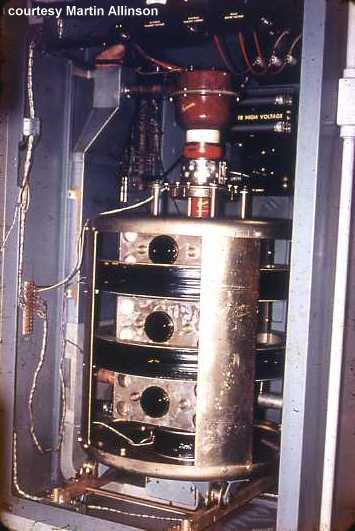
Klystron.
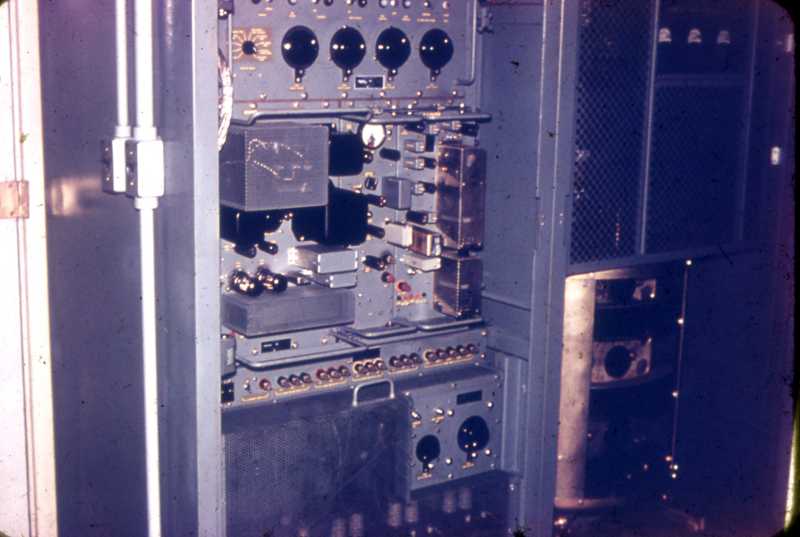
Master Oscillator panel.
And the end module was the Generator Room, with two 10KW generators driven by diesel engines. During summer 1960, these were changed to 20 KW units. Fortunately the sound insulation was good and the noise of the diesels was quite acceptable, even in the Radar Room.
WINTER ON AN I SITE This was the really testing time. The four of us lived cooped up in the Modules, with no contact with one’s “nearest and dearest” except letters that arrived fitfully. Our main entertainment was endless games of pool on the miniature table that, with a cover on, was also the dining table. And, on average once a week, we would be sent a movie which we projected on a small foldaway screen. No television, no radio, and any newspapers would be at least two weeks old on arrival. This was before the days of c assettes of recorded music, but we did have a record player and a few records that we played over and over. As the Radician, I was lucky in that I had the desk in the Radar Room as a place to write letters or read a book. And I was fortunate that, before my winter at FOX E, I had been at FOX D through the Autumn, and at DYE for Christmas—-the others had already been at FOX E for months.
STATION CHIEFS I developed, and retain, a great respect and admiration for the four I Site Station Chiefs that I worked with. I have a photograph of Frank Tilzey that was taken at Christmas 1958, when Frank was a Mechanic at DYE Lower. The only photograph of George Coffey that I can find was taken as I was leaving FOX E after my first spell there. George is on the left of the snowmobile. Later I knew Wally Paterson at FOX E and Earl Roberts at FOX D. The photograph of Wally Paterson shows him with sled dogs. Wally and animals had an instinctive affinity for each other; and Wally was saving so that he could own his own farm in Ontario.

Frank Tilzey. All dressed up and no place to go.
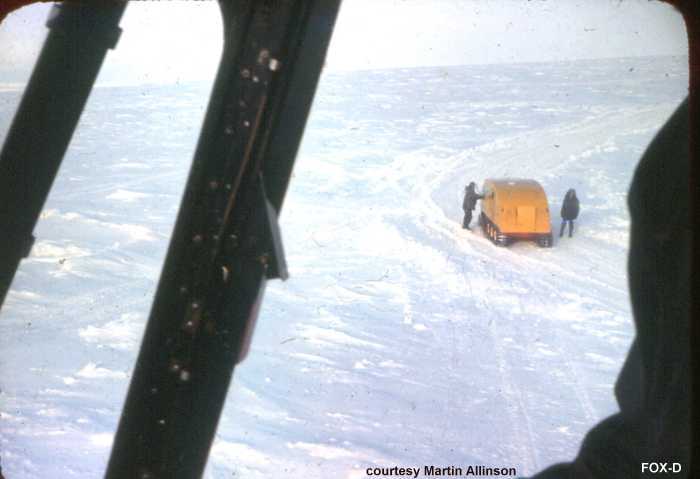
George Coffey on left.

Wally Paterson.
And here (below) is Earl Roberts, waiting to unload an incoming flight at FOX D strip. It also shows the Station (above Earl’s head, at the highest point on the skyline).
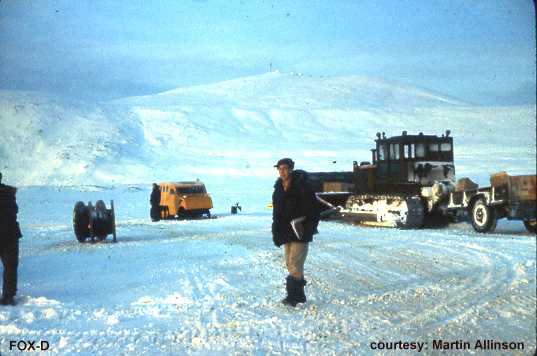
The Station Chiefs carried all the responsibility for the operation of the Station, and the well-being of its personnel, as well as doing a full day’s work as a Mechanic. (Nowadays I meet these modern managers with their BA’s and MBA’s and think “Very impressive—-but you wouldn’t have lasted a fortnight as an I Site Station Chief” !). To be a manager but never able to have a private word with your boss; and to have no room to yourself, but live the whole 24 hours in a room that was Station Office, and dining room, and social room, and a shared bedroom, was asking a lot. The photo above shows how close everything was. And yet all the four I-Site Station Chiefs that I knew ran thoroughly harmonious Stations. Great men.
I only knew of one of them losing his temper ; and then only the once. It was at FOX D. We had had a good blizzard during the night before and the result is shown in the above photograph. The Generator Room emergency-exit door had blown open and most of the room was swimming in water and half-melted snow. The “inside” Mechanic was a young Dutchman, known as Booey. (I never did know his proper name). He always did his work, but he was well known for making it as easy as possible. On this day he simply cut a hole in the Generator Room floor, and read a magazine whilst the water drained away. Frank went ballistic. Booey got a new one, but whether it was punched, bored, or drilled and reamed, he wasn’t sure!. However, it was soon all over and we knew that was the end of the matter. Frank wasn’t one for keeping bad memories alive. But that Mechanic was, for ever after, known as Short-Cut Booey.
GOOD TIMES After I had been at FOX E for a couple of months, a new Radician was sent from DYE to be trained up to take over from me. I found this made a great improvement to life. With two Radicians on site each could have some whole days off, which was never possible when one was the sole Radician. In fact, a sole Radician could never be far from the Modules. And, if out, he always had to be using a vehicle so that he could be summoned back by the vehicular uhf radio, if there was an alarm from the Radar Room. But with two on site, one could happily go off in one of the bulldozers and push snow for an hour or two. Or get an Eskimo to teach him how to build an igloo (See photo below). Also it eased another of the sole Radician’s frustrations: chopper arrival.
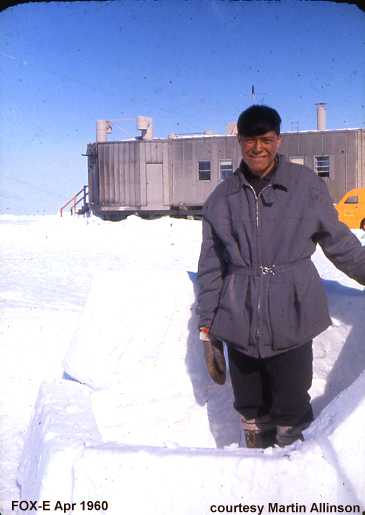
Building an igloo.
CHOPPER ARRIVAL Because of the expense, the chopper only flew when there was a load that couldn’t wait. And sometimes not even then, if the weather was bad. It wasn’t unusual to go ten days without getting mail and movies. So when the chopper did come it added a bit of excitement to the day. Everybody but the Radician would be down at the pad for a meet and greet. Our “baggage handlers” were equipped differently to their counterparts down South. The photo below shows our Eskimo garage-worker, Silucee, driving the small caterpillar tractor, and Camille Roy (Mechanic) riding on the sled whilst taking the outgoing load to the chopper. But the Radician had to stay in the Radar Room to do his ‘air traffic control’, so he didn’t normally get to see even the one fresh face. But when there were two of us we could take it in turns to get a share of this welcome break in the monotony.
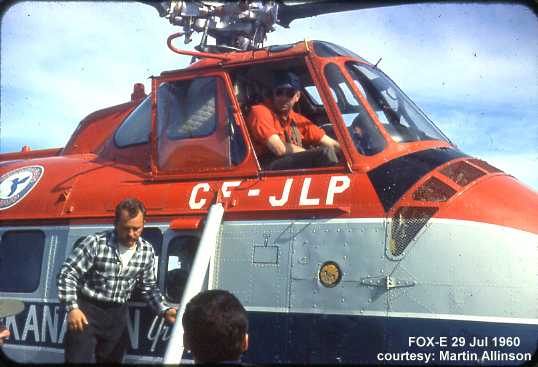
Meet and greet. Particularly if there was mail.
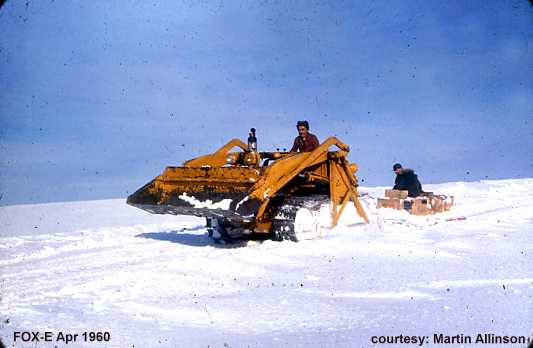
Silucee, on the job.
MANNING THE “I” SITES Filling the I Site Radician positions gave the SCCE (Sector Chief Communications and Radar) a lot of headache. I think there were 32 Radician and Comm Centre Operator positions to keep filled at FOX 4, FOX 5, DYE MAIN, and RES X1, but the SCCE reckoned that finding just the two for the I Sites gave him as much trouble as finding the other 32.
Obviously they had to be volunteers. To have someone on an I Site who didn’t want to be there would make for great problems. And only a small minority of personalities would countenance the cramped conditions and the isolation entailed in I Site service.
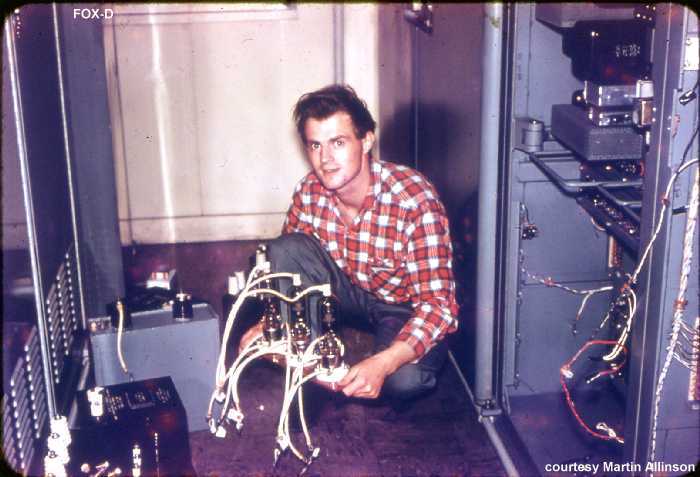
Do not disturb. Radician at work!!
But also men who were keen on electronics, and wanted to feel they were advancing their knowledge and experience, scorned the I Sites because there was so little technical content in the work there. When once I had to strip an hv power supply in order to replace a defective transformer at the back, it was such a rare occasion that I had a photograph taken (above) to show that I Site Radicians did do a bit more than just take their daily meter readings! And there was no job satisfaction to come from feeling that one was doing a vital job. After a few spells on a console, we all knew that the Aircraft Alarm System (for which the I Sites provided the beam) was of zero importance. In the SCCE’s delicate phraseology, “The AA is as unnecessary, and useless, as the tits on a bull”. (When the Line was being planned, in 1953, it had made sense to let it be known that it would be effective against low-level, as well as high-level, penetration. But the AA had been overtaken by events. Aerospace technology had developed in the direction of high-level bombers. There had been no development of low-level penetrators that could possibly carry enough fuel to bring them from Russia to populated Canada, never mind get them home again. Also the DEWLine surveillance radar was proving both effective and reliable. Any Russian submarine sitting in the Davis Strait that recorded the ground to air traffic from the consoles to our lateral DC3’s, would have proved to Moscow that low level penetrators wouldn’t get past without being detected. So, by 1959, it was clear that the AA System was redundant; and, in fact, it was soon to be decommissioned. “Tits on a bull” was a harsh comment, but a perfectly accurate analogy.)
The SCCE (whose surname was Cook (or Cooke), I think) had decided that the best tactic was to look at all new arrivals from Streator and, if they had the right personality, to encourage them to volunteer to try an I Site. So my volunteering to be I Site Sector Radician had been music to his ears—but he hadn’t let on. To encourage potential volunteers, he would promise real support. And we discussed ways of living up to that promise. For instance, there was good Ham equipment available for any Hams to take with them, and we thought we could even wangle Heathkits for those who wanted to do some constructing. I put in to the Suggestion Scheme a request for the issue of a really good manual on nursing matters (the US Navy Manual for their medical corpsmen). We got the support of the Sector Super on that— though I was prevailed upon to delete my remark that Streator only trained us to be corpse men!.
And, above all, we would invent excuses for the Sector Radician to have to pop in for a couple of days (and then hang around for a week waiting for a flight out) so as to give the Radician some days off. The SCCEs colleague in charge of the Mechanics, who was, I think, entitled SCOP (Sector Chief Outside Plant) was keen on this, too. He had asked me to give Frank Tilzey a hand with the station paperwork (which wasn’t Frank’s forte) and this had worked well; so the SCOP saw that having the extra Radician coming in for part of the time also had benefits for his people. I was to feed the SCCE photographs of the good side of I Site life, such as fishing for arctic char. But the SCCE didn’t want to know, officially, about all that happened on days off—such as expeditions to Padloping, or accompanying walrus hunters (photos below)!
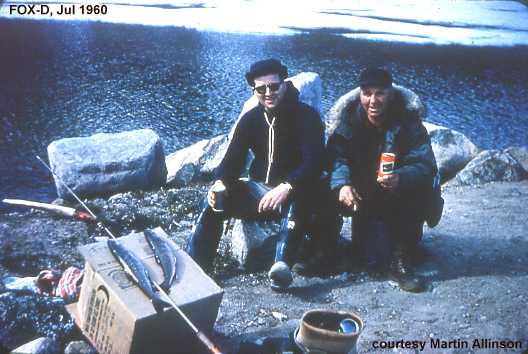
Fishing for Arctic char.
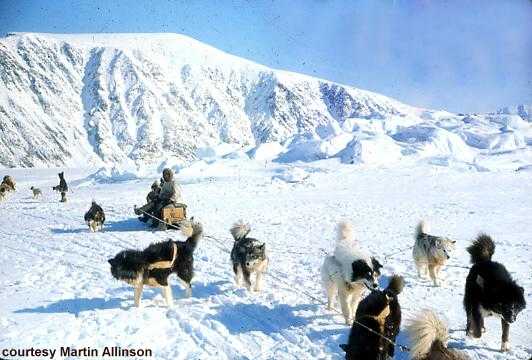
Expeditions to Padloping.
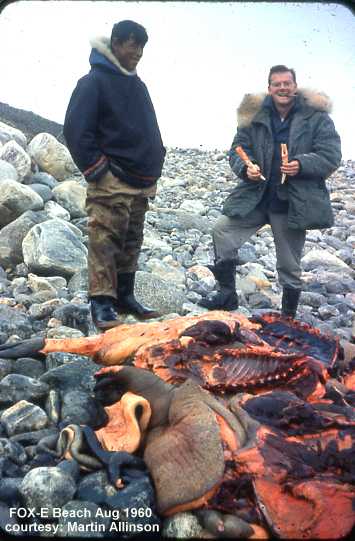
Accompanying walrus hunters.
NOMAD So it came about that the later half of my contract was spent nomadically. My main activity was to go to and fro between FOX D and FOX E (via DYE Lower and a brief look-in at DYE MAIN each time). The only exceptions were when I was “lent” to RES X1 once, and to DYE MAIN twice, to cover short vacancies caused by one of their Radicians going out on R&R. Having been a young mountaineer, I was used to packing up and moving on; so it was just a matter of taking things as they came.
HURRIED DEPARTURE One morning I had just woken up in a room at DYE MAIN and was thinking about dressing, washing, having some breakfast, and then wandering over to see if there was anything to do in the Sector Electronics Workshop, when somebody came to tell me that the SCCE was sending me over to FOX E (I can’t remember why). I said I’d get over to the SCCE’s office, catching a bit of breakfast on the way; only to be told “You’ve no time for that. The chopper is picking you up here. It’s on its way up from Lower Camp now”. So all that I had unpacked in that room (fortunately not much) had to be hastily thrown into a couple of holdalls—just spare clothes and my emergency-survival sleeping bag wrapped round an emergency-survival bottle of medicinal ethyl alcohol. And that is how I once came to arrive at FOX E looking like death warmed up: unshaven, with sleep still in my eyes, my belly rumbling emptily, and dressed in quilted trousers and a parka that hid my pajamas.
THE DAVIS STRAIT TRADER The Hudson Bay Company didn’t have any presence at Cape Dyer, Durban Island/Padloping, or Kivitoo. But , in the interests of supporting the lads and the eskimo-worker families at the I Sites, I did my best to make up for the absence of HBC. The FEC eskimo workers would do carvings and we would buy seal skins, foxskins, and even the occasional polar bear skin from Eskimo hunters who came to us from Padloping or Kivitoo. I was the middle-man who passed these on to people at Cape Dyer who wanted to take a souvenir home at their End Of Contract.
That way, FOX D and FOX E would acquire extra creature comforts. A typical trade would be a quite-ordinary seal skin for ten back-numbers of Playboy.
But for a really nice sealskin I would get the acquirer to leave me a full holdall of work clothes as I knew these were really appreciated by Kivitoo and Padloping residents for wearing under their furs.
And the eskimo-workers’ houses got better and better equipped. I can’t claim to have sold a refrigerator to an Eskimo, but I have helped one to choose one from Eaton’s Mail-Order Catalogue.
RETROSPECTIONS I left the Line after finishing one contract, with just a month’s extension. I felt very honoured that the Sector Superintendent, Jesse Covington, wanted me to come back and be Station Chief of FOX E: and I was quite tempted. But my wife pointed out that we had got what we set out to get—enough money to live well whilst I did a year of postgraduate studies, and a bit more besides. She was right. The money from the Line made a big difference to us for the next ten years or so.
There must be hundreds of untold stories of how savings from a period of work on the DEWLine got a young couple off to a good start, or even founded a family business. I know that I wouldn’t have got my Lectureship at a good technical college without those postgraduate studies. Nor would we have then been able to buy the houseboat on the Cam, and so live in the centre of Cambridge, without the savings from the Line. And, later, that money allowed us to buy a small hill-farm in the mountains of Wales, when I went there to work at a nuclear power station.
Thank you DEWLine for all the fun, the experience, and the little pot of gold!
With affection, Martin Allinson, August 2003, NE Thailand, (E. & O. E.)
The Evolution of the DEWLine Training Centers
Streator and Beyond
By Tony Henriksen and Clive Beckmann
Editors note: The information below may be the most definitive history of the DEWLine training facility relative to the transitions from Streator to Colorado Springs, to Winnipeg. More information and photos of the Streator site can be seen here.
Brief Bio’s
Tony Henriksen has a wealth of knowledge about the DEWLine. He was an Alaska Radician back in the early ’70s and then transferred to Streator as an instructor. He was with the training program during the Project Head Quarters (PHQ) and Winnipeg (WINT) years. He was chief honcho at WINT, later transferring to the engineering department at PHQ. He eventually became a senior manager (DC) at PHQ (originally this slot was called Manager Ops), the top Communications & Electronics (C&E) job of the DEWLine program.
Clive Beckmann served in the C&E department of the Alaska Sector of the Dewline during the years 1965-90. The various job titles held are: Radician, Sector Radician, Lead Radician, Instructor Radician and Area Radician. He attended the Streator training facility in 1965; and again in 1975 for refresher training upon rehiring after a 3-year hiatus from the DEWLine. In addition, Clive attended a number of DEWLine sponsored commercial schools: OKI Discovery I EA PBX; M40 Teletype Systems; REL Troposcatter Radio upgrade; Westinghouse FPS-117 maintenance; NX4000 LF Radio Beacon.
Clive is retired and living in Arizona.
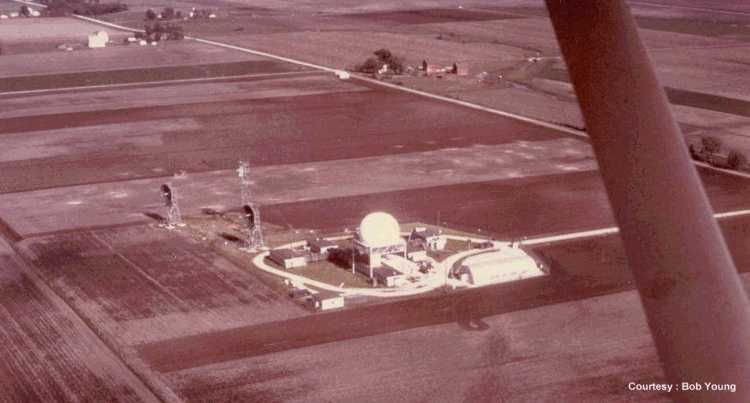
Training site, late 1950’s. Note the radome is in place.

Training site in 1968. The radome was removed to replace the one at DYE-4 that was damaged in a massive wind storm in 1963. Photo courtesy of Vintage Aerial.
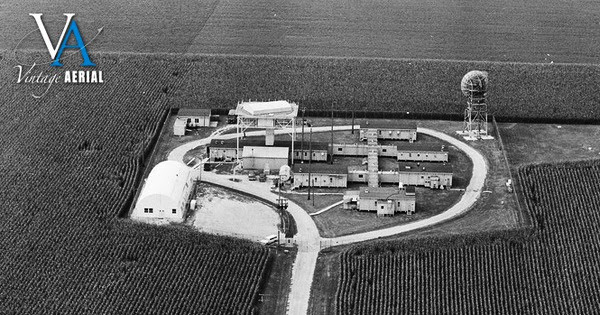
Another view of the training site in 1968. Photo courtesy of Vintage Aerial.
Recollections:
Clive provided the following information:
– The Streator site location was selected based on the fact that it was surrounded by corn fields (check out Google Earth from an altitude of about 20 miles) that were thought to mimic Arctic tundra as seen by the radar and troposcatter radios.
– Construction was begun concurrently with Arctic prototype sites Pow-3, Bar Main, Bar-1, around 1952. The sites were turnin’ and burnin’ in 1953, worked as predicted, and resulted in commencement of full-scale DEWLine construction in 1955.
-I believe it was referred to in teletype (TTY) messages as DTS, i.e., Domestic Training Site.
– The Streator site served as the training center for new-hire DEWLiners during 1953-1978. The training facility was then moved, first to Colorado Springs CO (fall 1978), and then to Winnipeg Manitoba (WINT) in the fall of 1982.
-The land for the Streator had been leased from a farmer and it is believed it was returned to the owner after operations ceased. (Note: pictures of the now-abandoned Streator training site can be seen here.)
Tony Henriksen’s recollections:
In response to a number of questions posed to Tony by Clive in 2010, Tony shared the following information.
1. During 1978-82, after the move from Streator, was there a dedicated training area at PHQ?
From the fall of 1978 to fall of 1982, the DEWLine Training Center was located NEAR the PHQ facility in Colorado Springs, CO. The exact location was in a building apart from the PHQ building (about 1 block away). The new training facility was co-located in the same building with the new DLM (Depot Level Maintenance.) The Colorado Springs training facility consisted of two classrooms, three offices, two console rooms and a simulator/control room. It also included two outside Stevenson Screens and external weather equipment. The backup Master DEWLine Library was also moved from Streator and was now located in the Chief Instructor’s Office.
The Operations and Weather courses were unchanged from the way they were conducted at Streator prior to the move. The Radician technical part of the training changed coincident with the move. The idea was to now teach equipment theory in Colorado Springs and we initiated “Hands On” training programs at PIN-M & DYE-1. The original instructor at PIN-M was Al Packham and later on was Al Stewart. John Ovits was the original Greenland Instructor.
2. Was the console moved from Streator to PHQ to support operations training?
Yes. Both consoles AN/FSA-14 and AN/FSA-26 (Greenland Console) were moved from Streator to Colorado Springs and later to Winnipeg. We also moved all the simulator equipment required to conduct Operations training. Other Ops training equipment moved were the Teletype machines and the Message Concentrator.
3. Was any of the other C&E equipment moved to PHQ, i.e., radios, etc?
Yes. Nearly all other C&E equipment was moved from Streator to the new DLM in Colorado Springs to be used as mock ups or for spare parts.
4. How did the curriculum change after Streator was abandoned? How long did the Radician course run? How long did the console op course run?
Console Operations, Weather and First Aid curricula were unchanged. As mentioned above, equipment theory only was provided for the Radicians at the Colorado Springs facility. Hands On training was now given at PIN-M and DYE-1.
The Operations Training (Console Ops, Weather, First Aid and CPR) totaled 6 weeks. This was true in Streator, Colorado Springs, and Winnipeg. The Equipment Phase of training was 6 to 8 weeks long. The length of this phase changed slightly a few times as the Air Force wanted ‘this or that’ equipment added, emphasized or as equipment was upgraded.
5. How did the curriculum change after the move from PHQ to WINT? How long did the Radician course run? How long did the console operator’s course run?
When the school moved from Colorado Springs to Winnipeg there was no IMMEDIATE change in curriculum. Approximately two years after the move to Winnipeg, there was a change. All of the Radician equipment training (theory and practical) was then provided at PIN-Main or DYE-1 and ONLY the Weather, Operations and First Aid given in Winnipeg.
The Operations Training (Console Ops, Weather, First Aid and CPR) totaled 6 weeks. This was true in Streator, Colorado Springs and Winnipeg. The Equipment Phase of training was 6 to 8 weeks long. The length of this phase changed slightly a few times as the Air Force wanted ‘this or that’ equipment added, emphasized or as equipment was upgraded.
6. Did WINT have a console and/or other C&E equipment?
Yes. Both consoles and associated simulators and TTY machines were again moved from Colorado Springs to Winnipeg. The DLM was moved from Colorado Springs to Winnipeg at that same time and all DLM C&E equipment was moved from the Colorado Springs DLM to the new Winnipeg DLM.
7. How did the status of weather (wx) training change in 1978 and in 1982? Did Canadian wx instructors still run the wx training program? Was a Stevenson screen and other wx instrumentation always available in the PHQ/WINT locations?
The weather training remained virtually unchanged throughout the moves from Streator to Colorado Springs to Winnipeg. All Weather equipment including Stevenson Screens and wind equipment were moved both times. The two Canadian Weather Instructors who were assigned to Streator at that time (Al Russell and Syd Heaney) moved along with the school from Streator to Colorado Springs & later to Winnipeg.
Tony Henriksen then went on to provide the following “trivia.”
One of the factors for locating the original prototype DEW Line site at Streator was its distance away from MIT University which had the other end of the experimental Ionospheric Scatter (troposcatter) link. Streator was the Domestic Main Station (DMS) with the Ionospheric Scatter to/from the MIT prototype. They had a Tropo shot from Streator to an Auxiliary Site prototype simulation near Rockford, Illinois and there was also an Intermediate site at Utica, Illinois.
Later on, they officially changed the name of the Streator facility to the Domestic Training Center (DTC). When the training facility was moved to Colorado Springs, we kept the DTC acronym but officially changed the meaning to DEWLine Training Center (DTC). This changing acronym has caused some confusion throughout the years.
